After a very productive (well, from a lounge review perspective anyway) stay in Hong Kong, it was now onwards to Tokyo-Narita and from there San Francisco.
I had managed to find some rare trans-Pacific award space on Japan Airlines, which I booked for 89,000 Asia Miles and S$293 in taxes. The flights were operated by two Boeing 787 Dreamliners- but with very different experiences!
| ✈️ tl;dr: JAL B787-8 Business Class | |
| JAL’s regional Business Class is a few generations out of date, with angled flat seats that lack storage space or privacy. | |
| 👍 The Good | 👎 The Bad |
|
|
Japan Airlines B787-8 Business Class
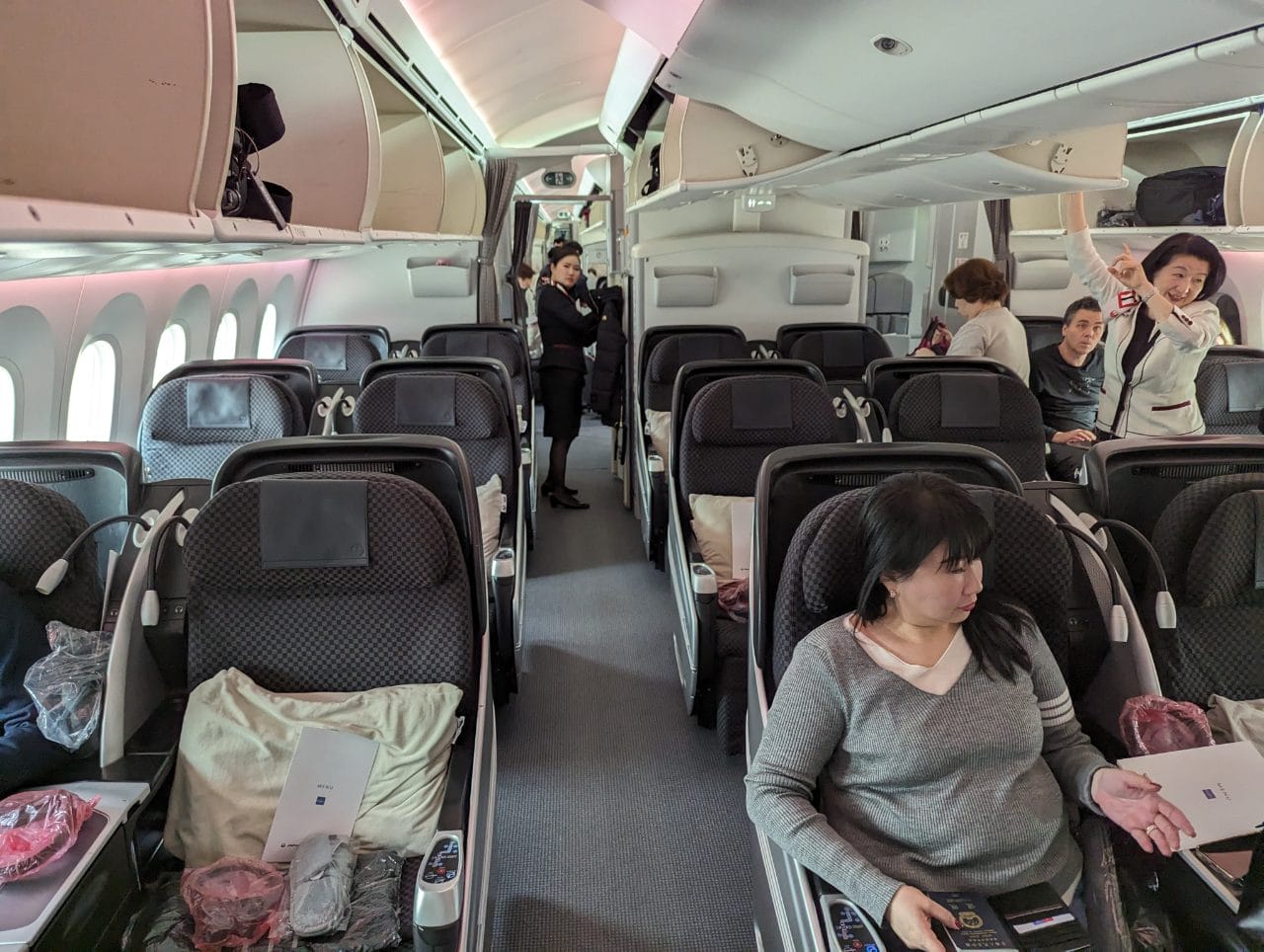
Japan Airlines has three different configurations for its 31 Boeing 787-8 aircraft:
- Type E21 is a three-cabin aircraft used for domestic routes, with 6 First Class, 58 Business Class and 227 Economy Class seats
- Type E12 is a two-cabin aircraft used for long-haul international routes, with 30 Apex Suites Business Class seats and 156 Economy Class seats
- Type E03 is a two-cabin aircraft used for short-haul international routes, with 30 Shell Flat Neo seats and 176 Economy Class seats
The Hong Kong to Tokyo Narita route is served by Type E03, which unfortunately meant a regional Business Class seat with only angled-flat capability, configured in a 2-2-2 layout with no direct aisle access for 33% of passengers.
This Shell Flat Neo product, introduced in 2012 along with the debut of JAL’s first B787 Dreamliner, is horribly out of date compared to more modern offerings like the Stelia Aerospace Symphony seats used by Singapore Airlines on regional flights. Sadly, I’m not aware of any plans to upgrade these seats anytime soon- you can forget about the Airbus A350-1000 Business Class ever appearing on this jet!
The 30 Business Class passengers are split into a forward cabin of 18 seats, and a rear cabin of 12 seats.
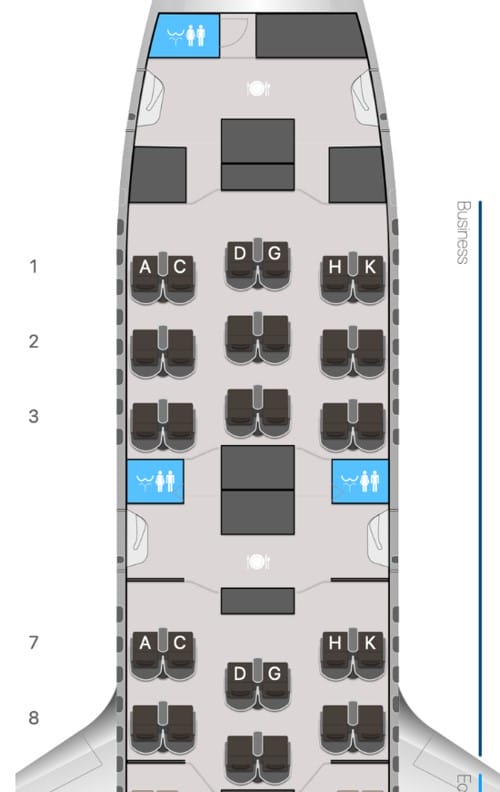
Couples will naturally gravitate towards the A/C or H/K seat pairs by the window, though I’d avoid Row 3 for its proximity to the lavatories, just behind your shoulder.
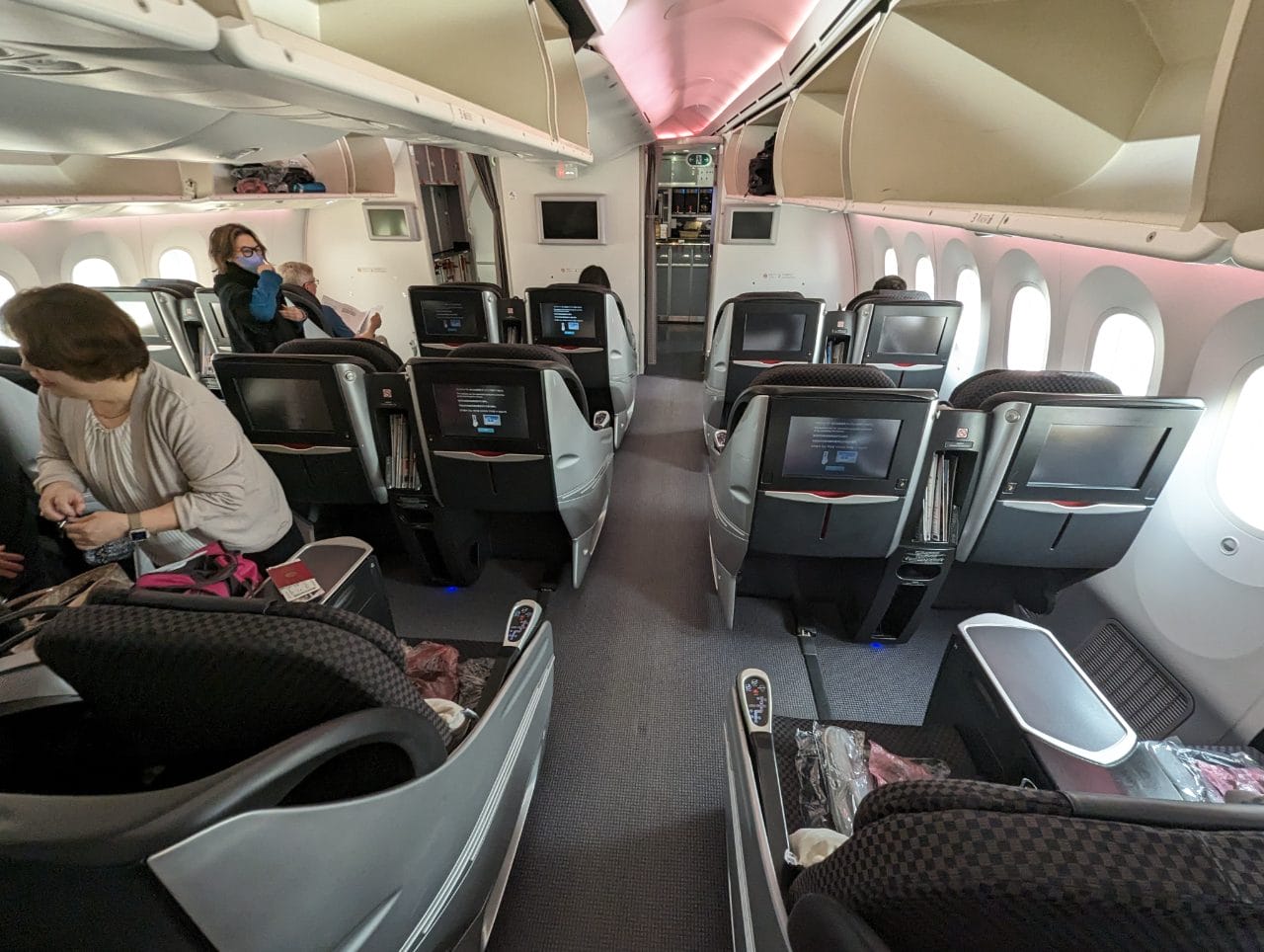
Row 1 should also be avoided because it has a smaller 10.4″ retractable display (versus 15.4″ for other seats), along with no storage pocket, magazine rack or plastic bottle holder, in a seat that’s already critically lacking storage space.
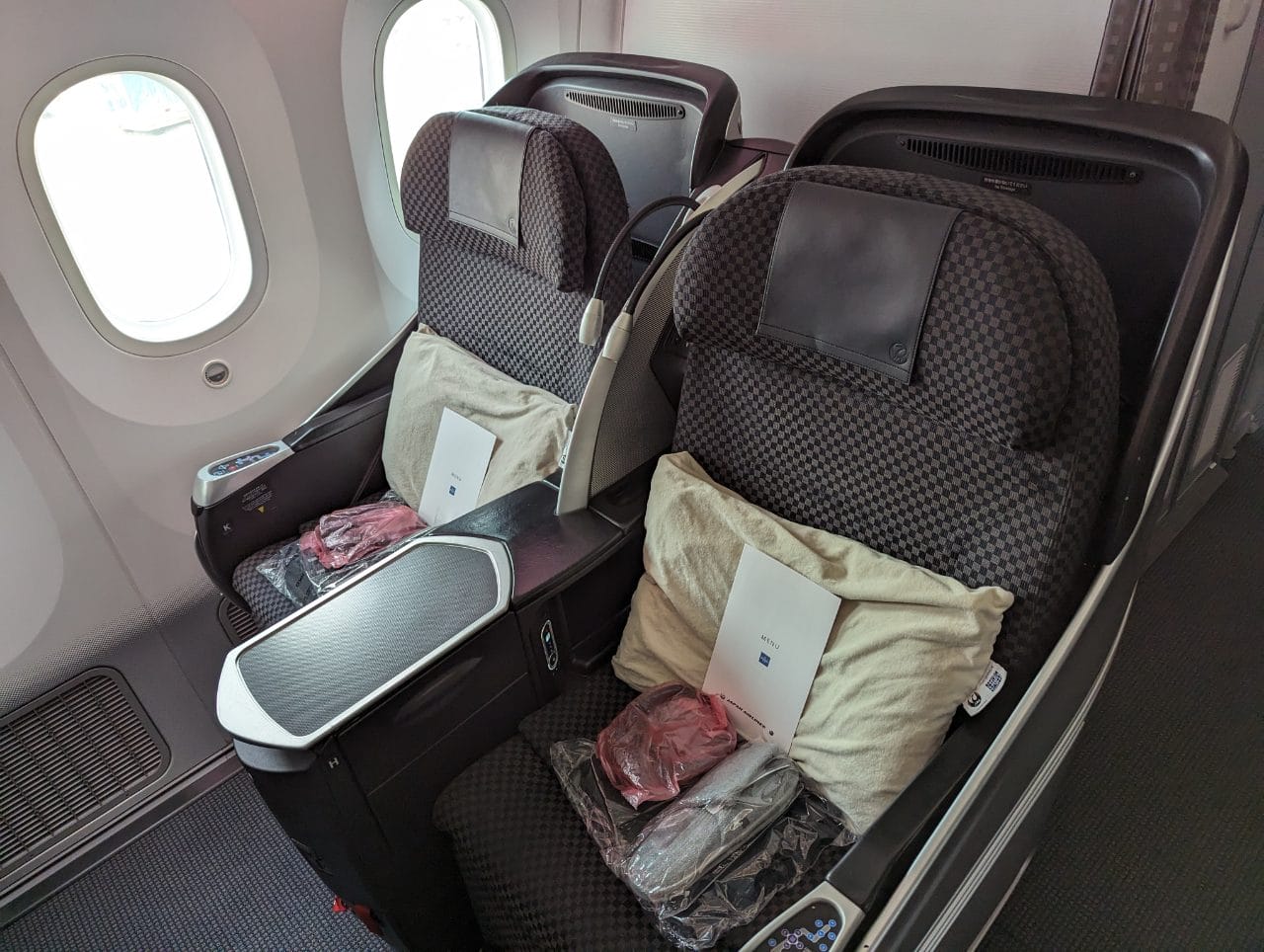
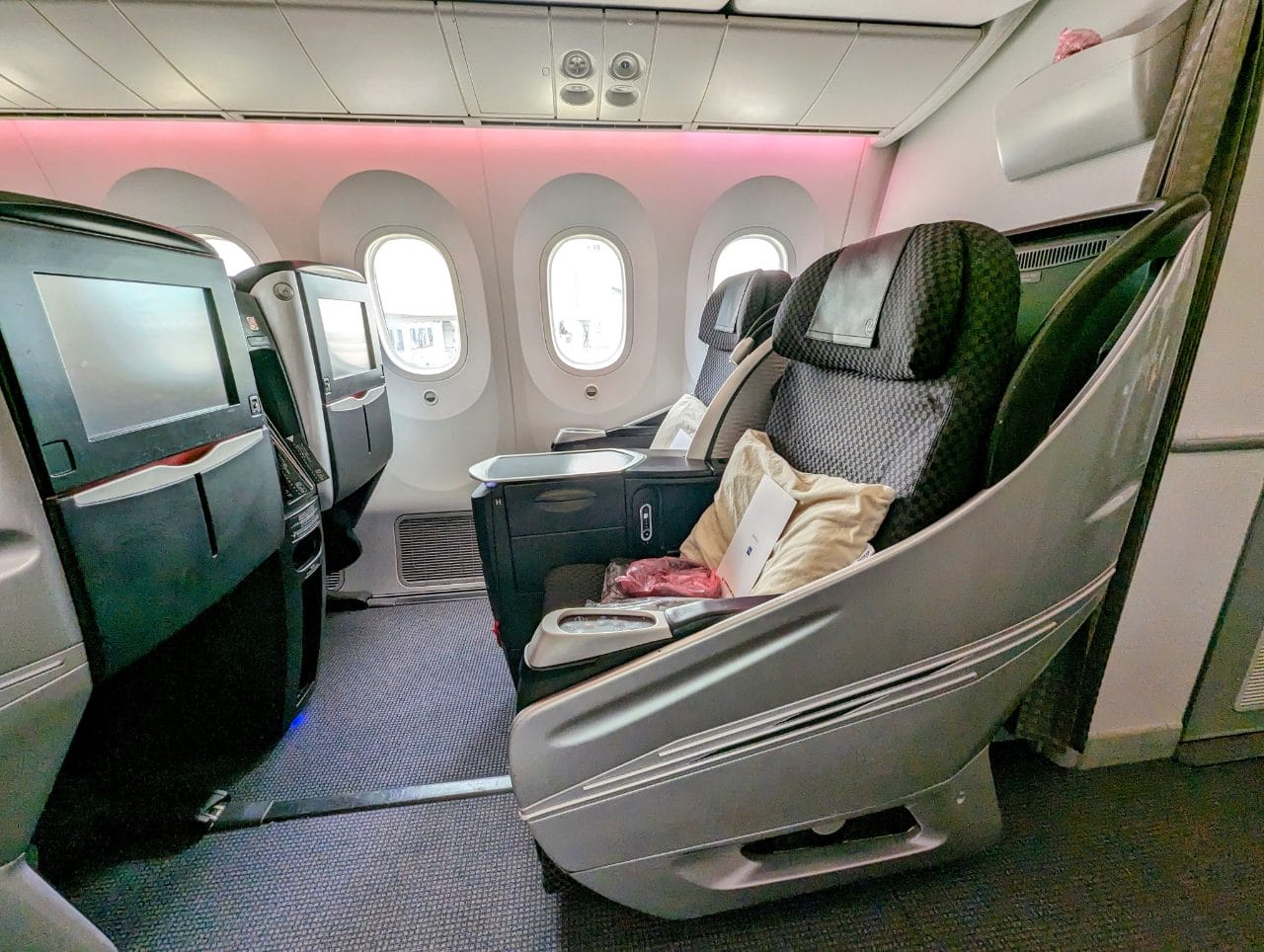
Solo travellers will try for the D/G seats in the middle, since it guarantees you aisle access without the bother of your seatmate stepping over your legs. But maybe you should make your acquaintance with your seatmate anyway- as the photos show, this seat has close to zero privacy. JAL hasn’t even bothered to install token privacy partitions, and a slight turn of the head will put your neighbour within eyeshot.
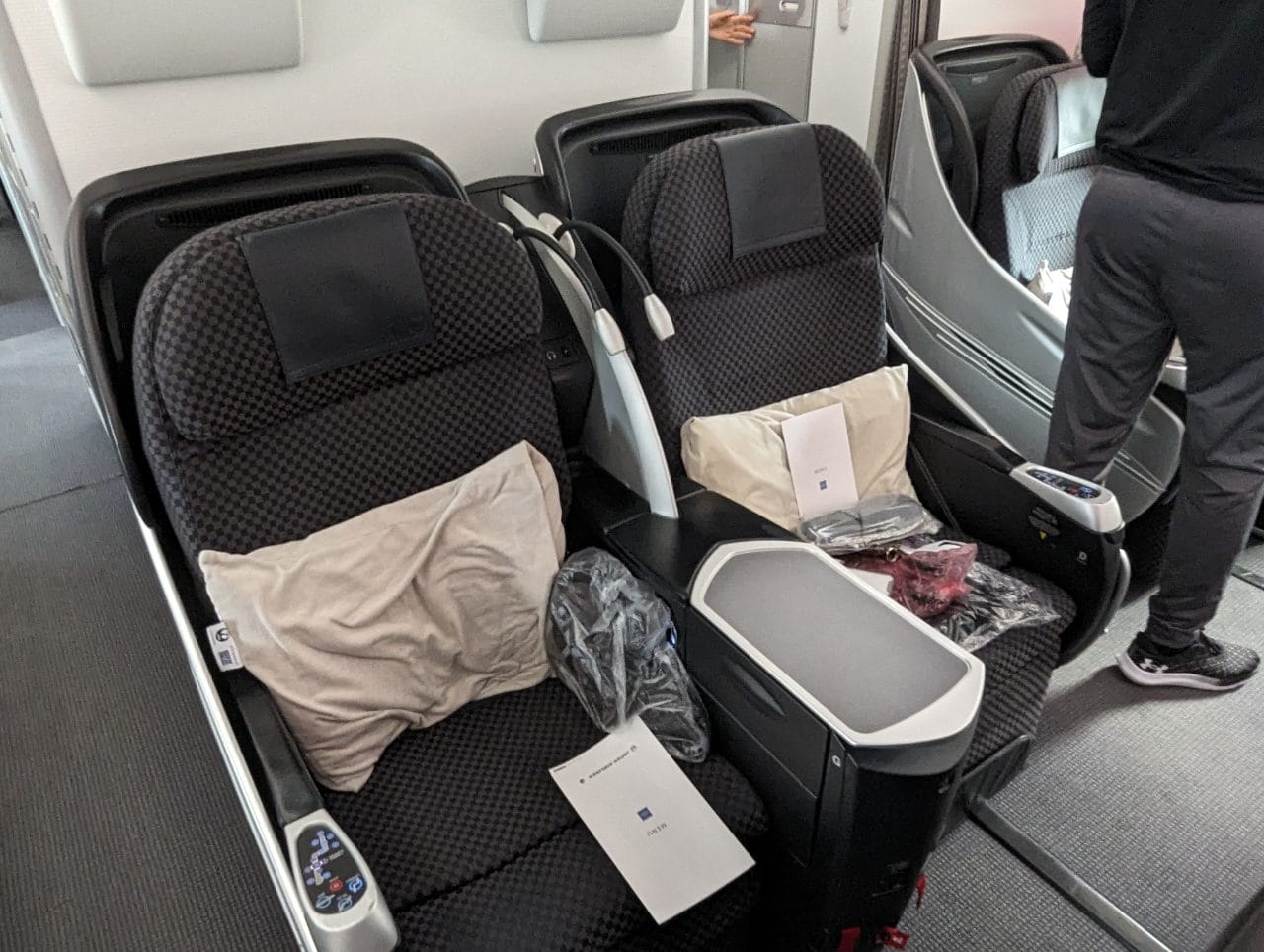
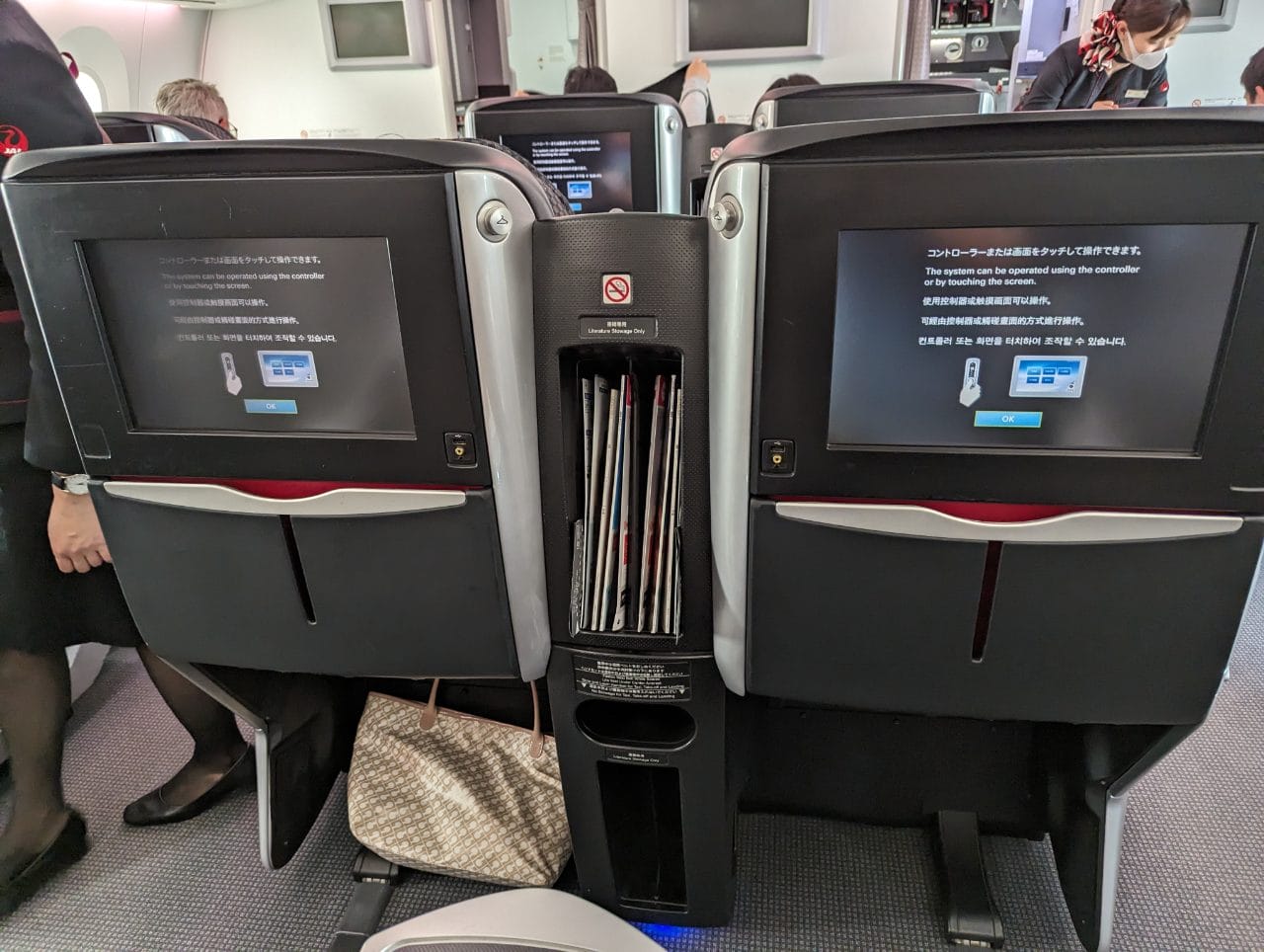
Since I booked this ticket late, I didn’t have many seats left to choose from, and settled on 3G, at the rear of the forward cabin. Some of the H/K seats nearby were empty, but it turned out those were blocked off because they had malfunctioning IFE systems.
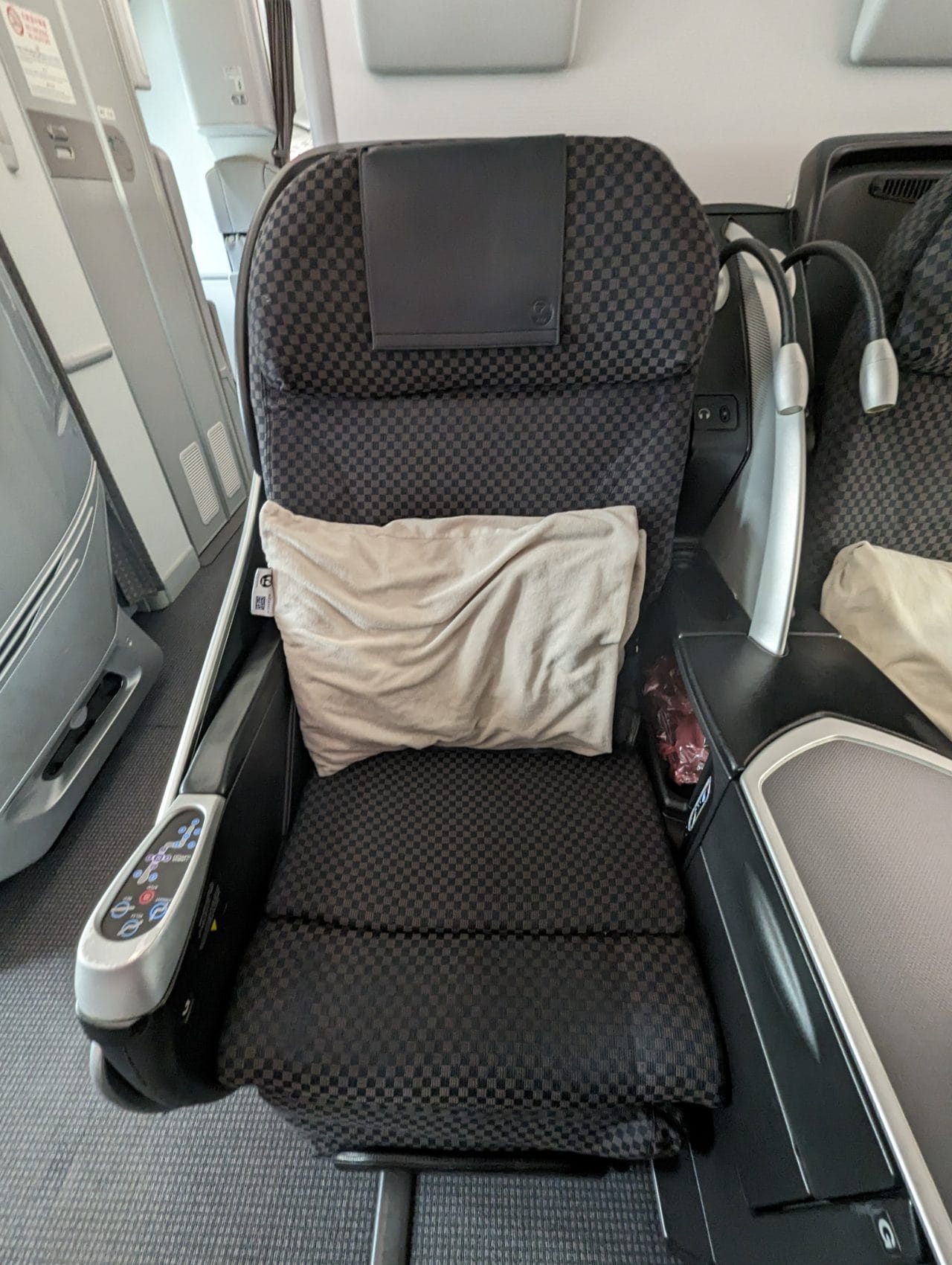
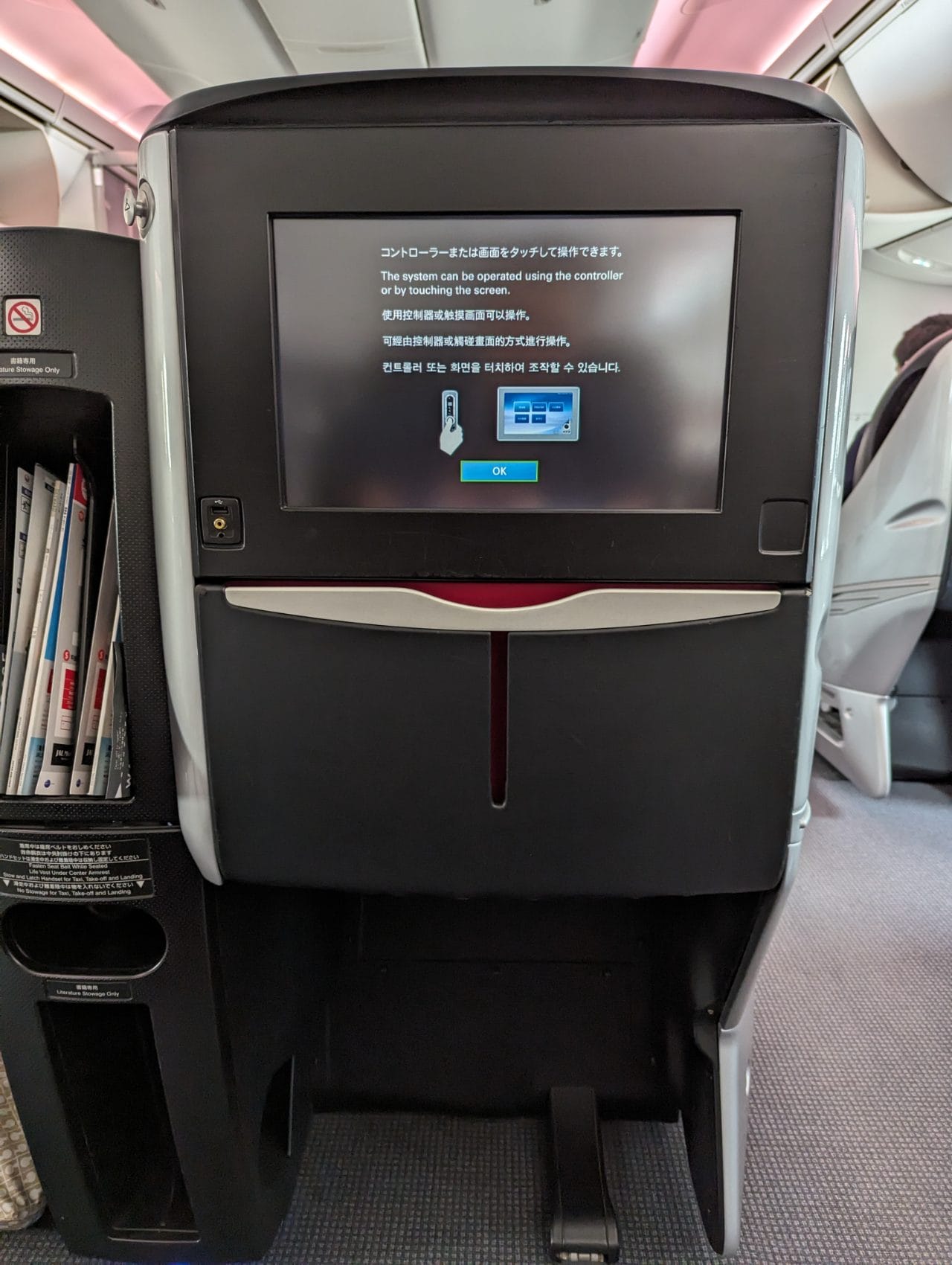
Shell Flat Neo seats are 21 inches wide with 60 inches of pitch. The padding is reasonably comfortable, but can sag in random places on account of how old it is.
Seat controls were found in the center armrest, with presets for full flat (or rather angled flat), full upright, and a partially-reclined relaxing position. You could also adjust individual components of the seat to your liking, or trigger a (very weak) massage function.
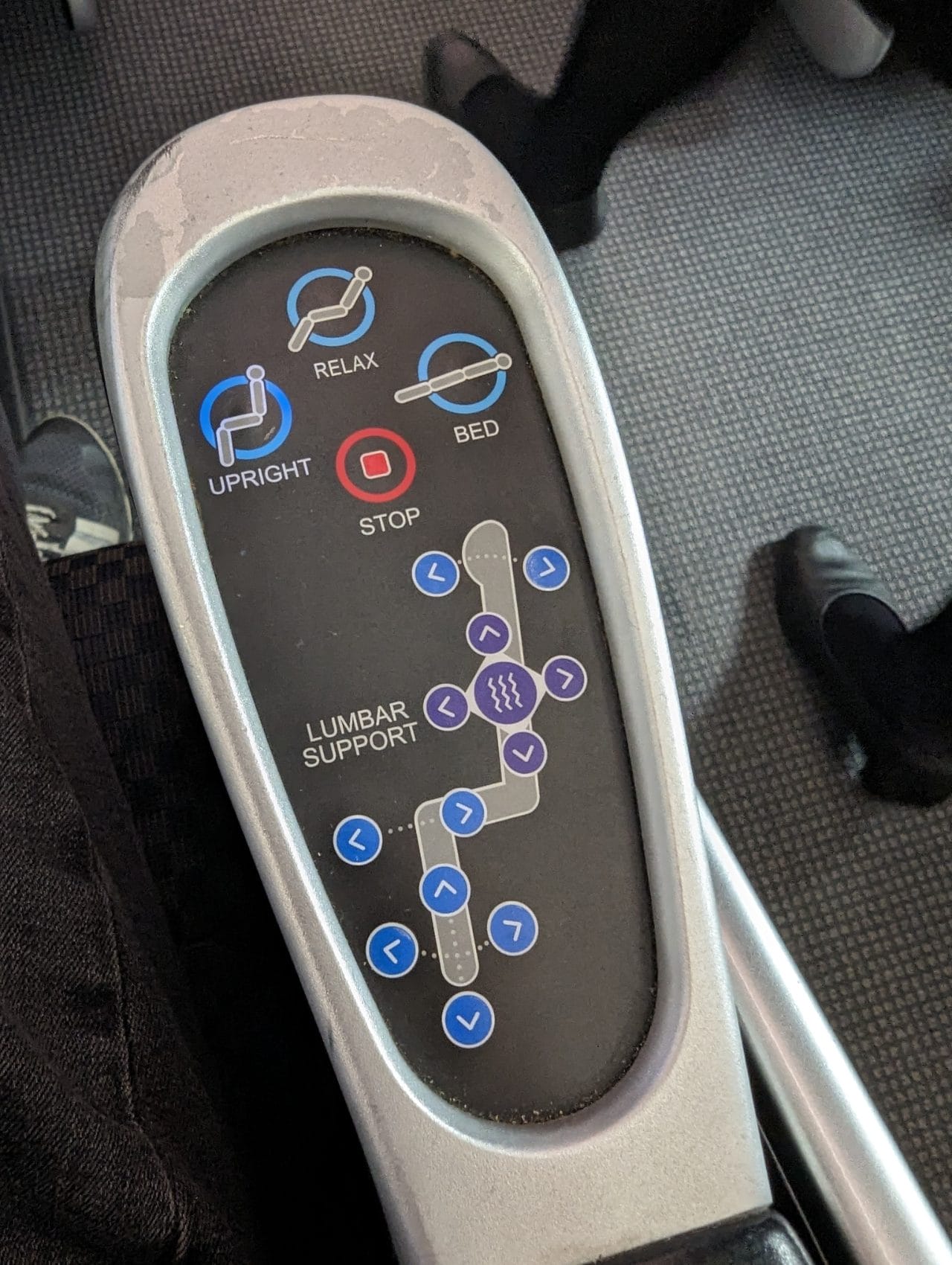
Additional seat controls could be found when the seat was fully reclined, allowing you to reset it to full upright at the touch of a button.
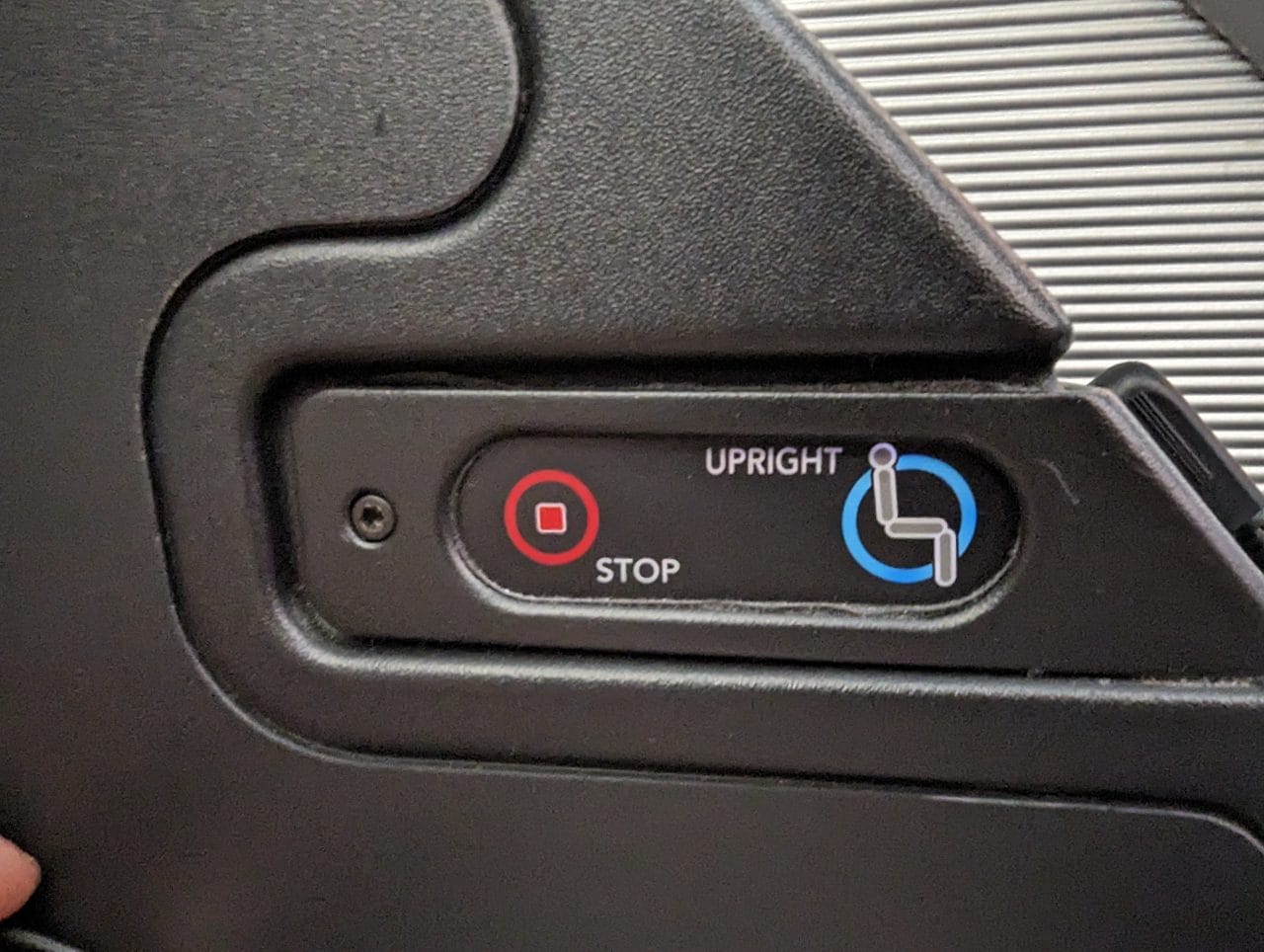
Behind your shoulder is a headphone jack and flexible reading light which you twisted to activate.
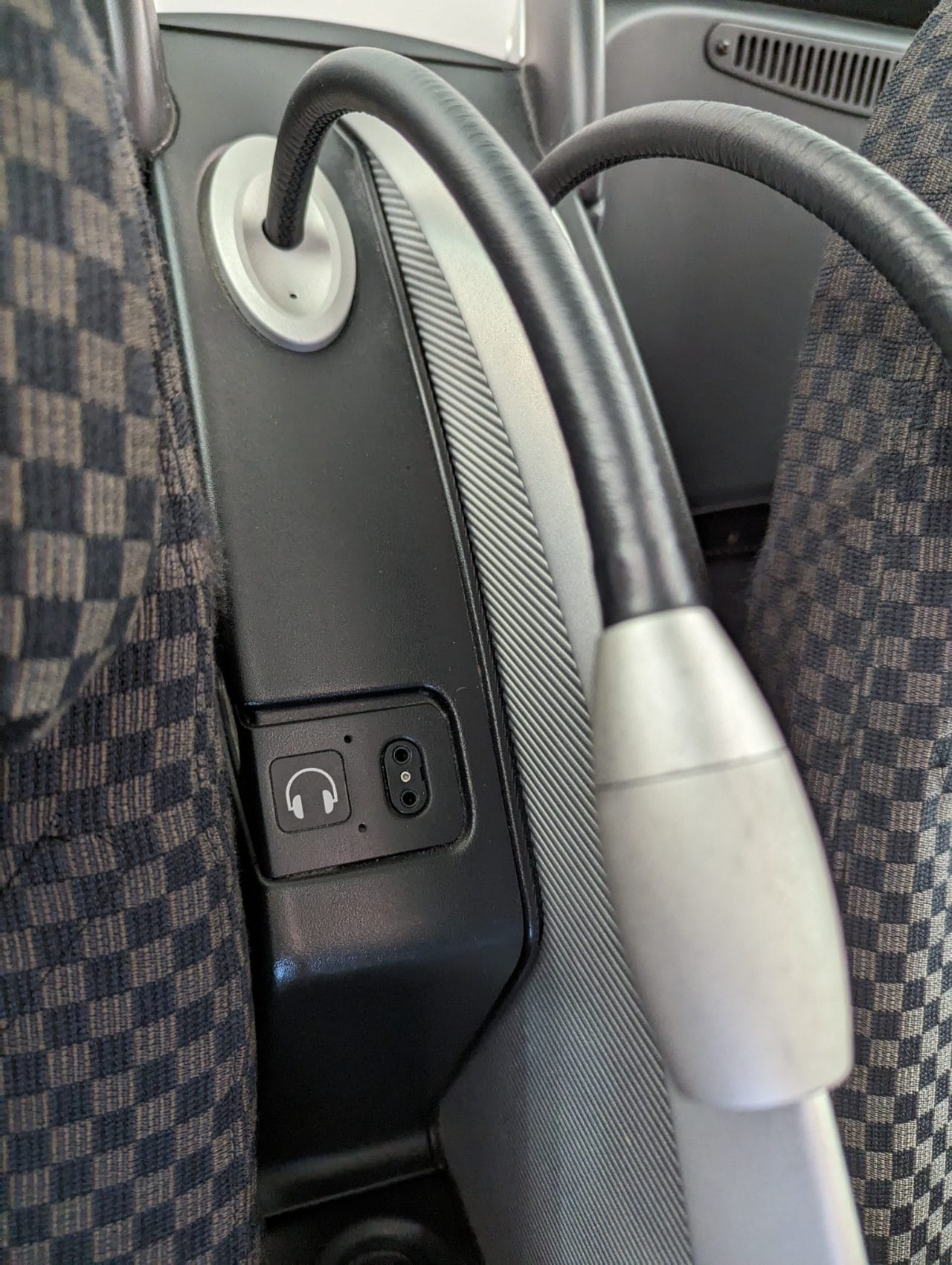
Further down by your legs is a universal power adapter (does anyone know why they install them upside down?).
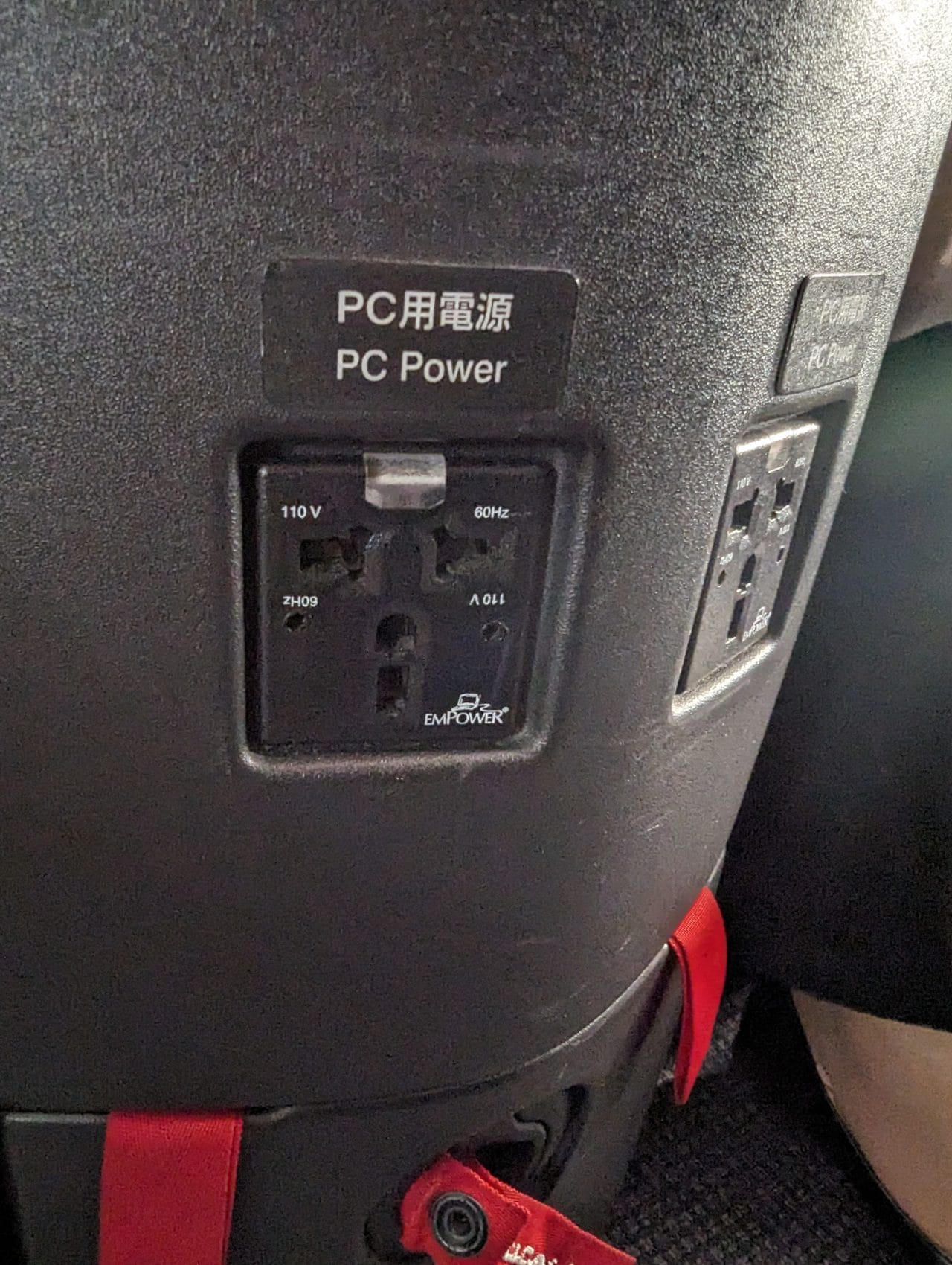
A USB Type-A port can be found just beneath the 15.4″ touchscreen display (along with an RCA connector, another reminder of how old this product is!). Since the seat pitch makes it uncomfortable to lean forward and press the screen, however, you’ll be using the wired remote most of the time. Also note that if you’re in Row 1, you’ll have a 10.4″ retractable display that fits into your armrest.
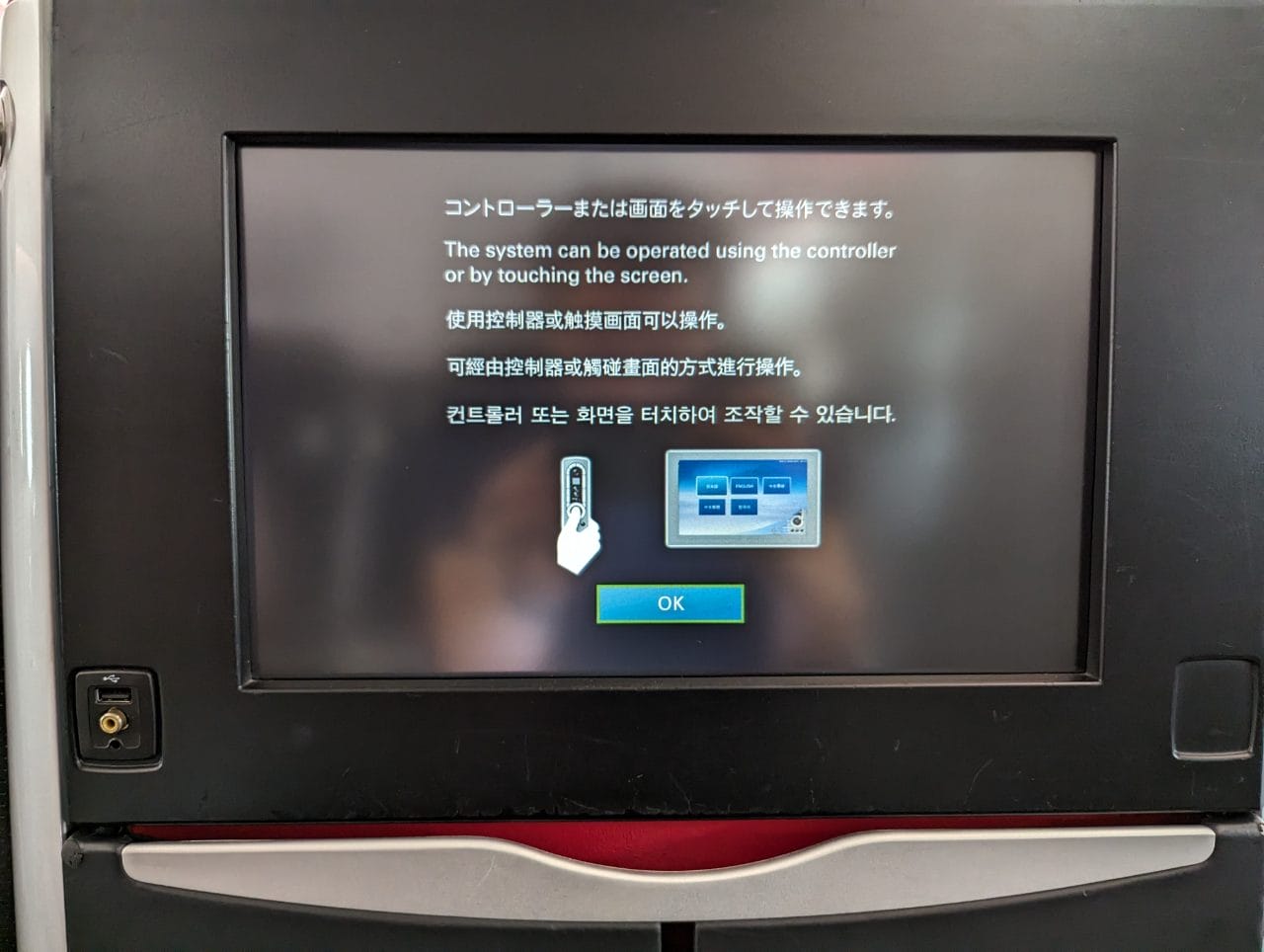
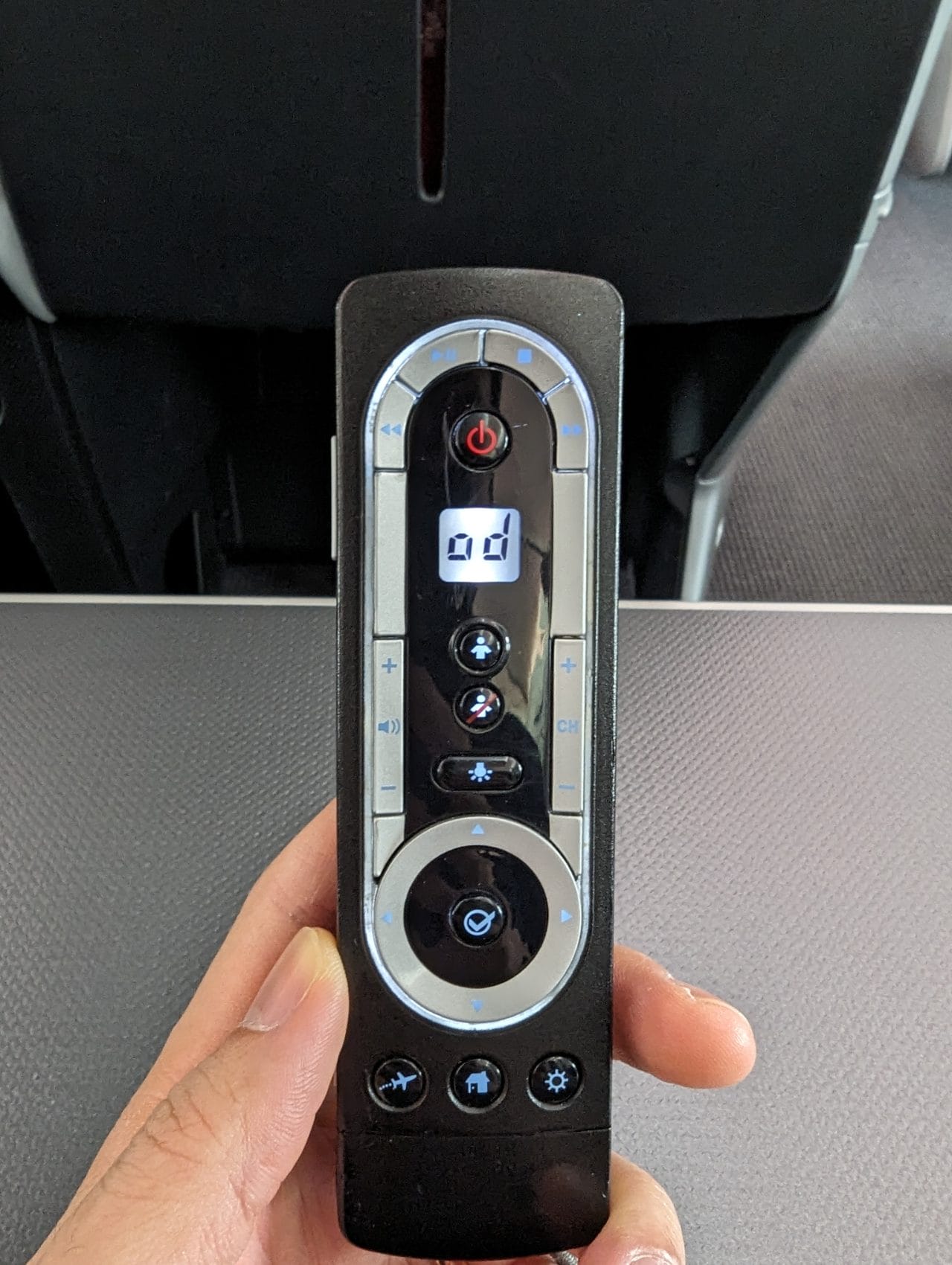
One of the major drawbacks of this seat is that storage space was close to non-existent. The compartment in front was already crammed full with airline literature, and the pouch beneath the screen would fit at best a slim laptop, with some unsightly bulging (the crew seemed fine for passengers to stow items here during take-off and landing).
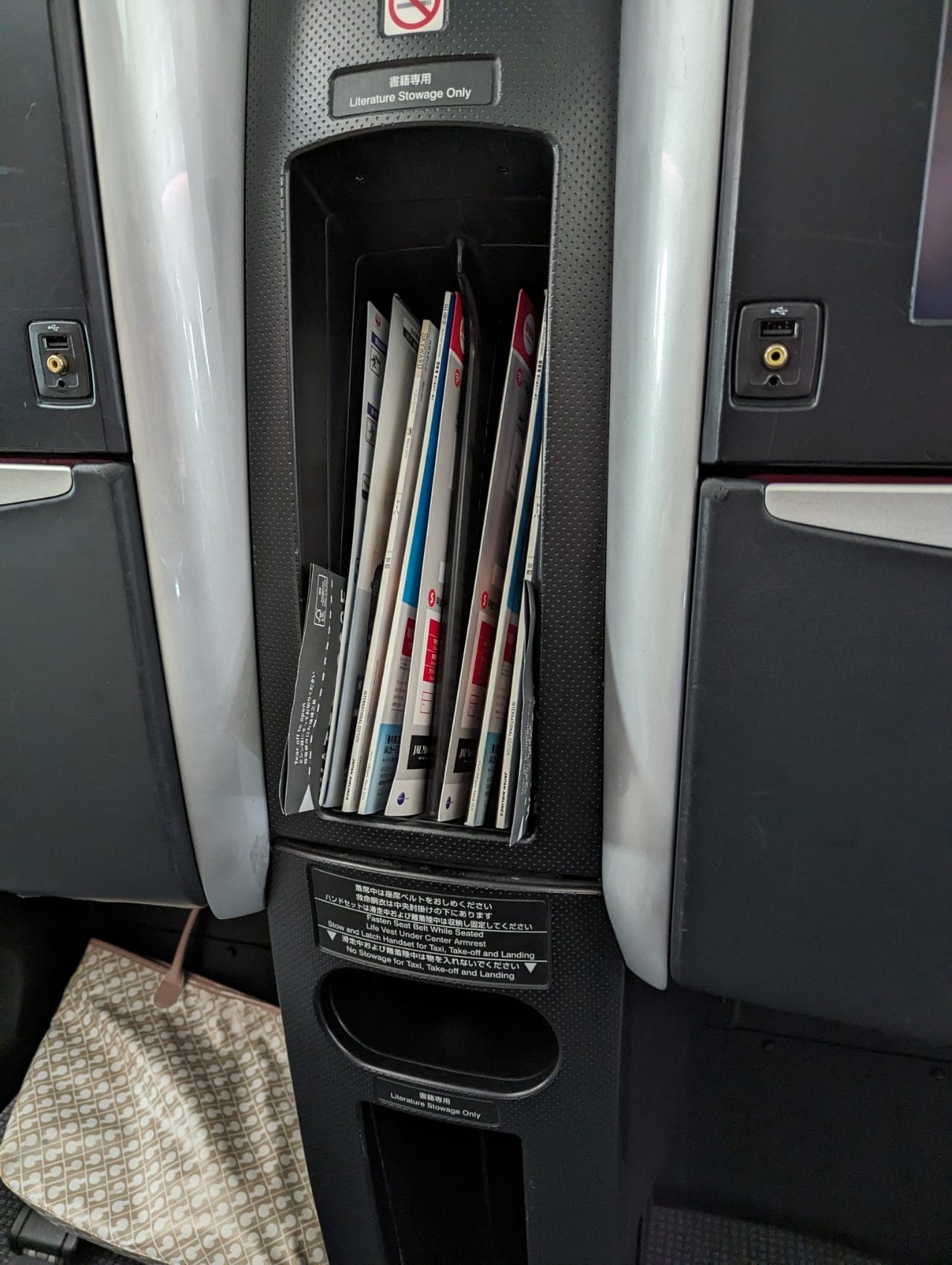
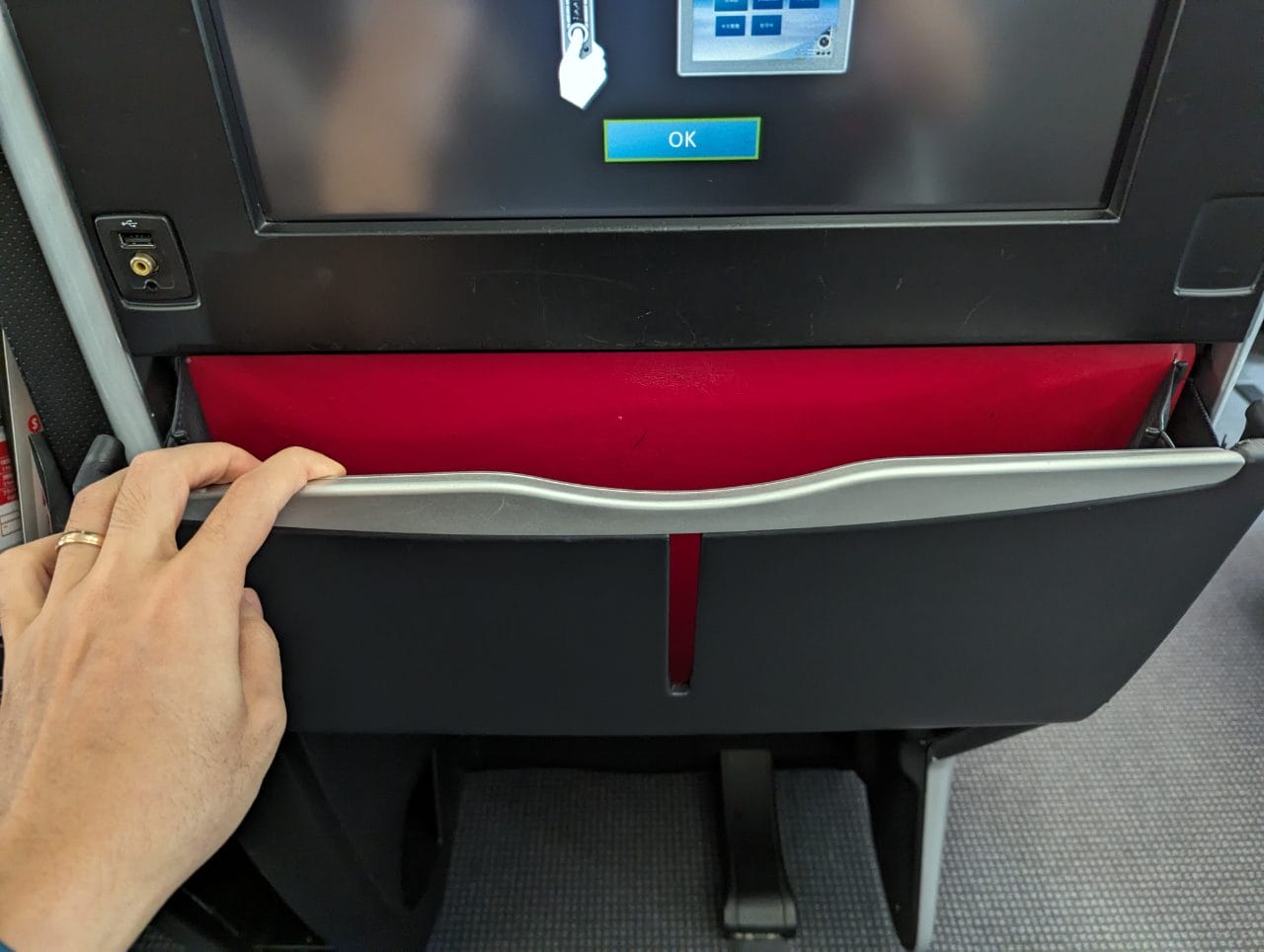
The tray table was large enough for my 14″ laptop, but the design wasn’t as sturdy as I would have liked, resulting in a slight bouncing effect when typing.
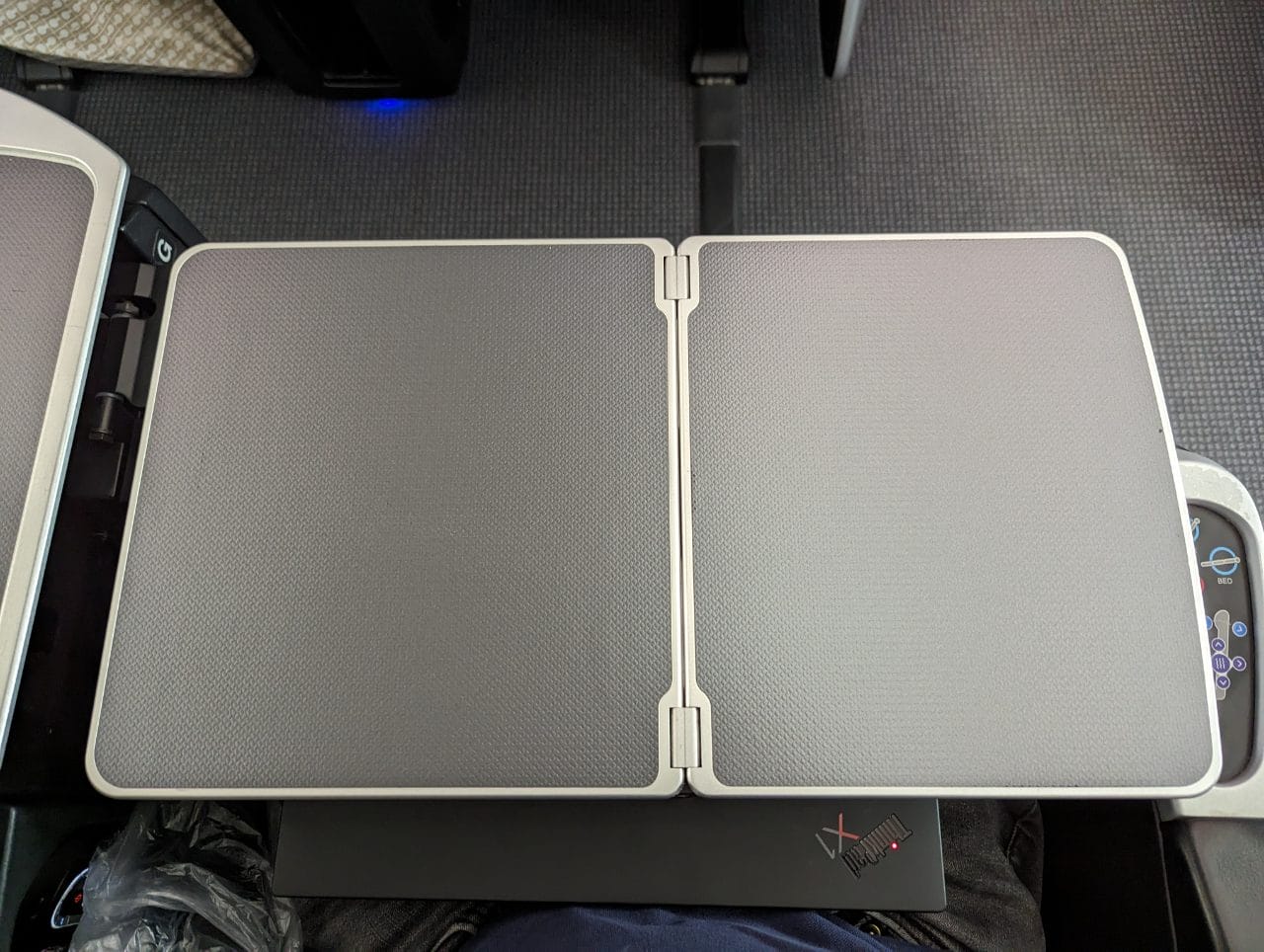
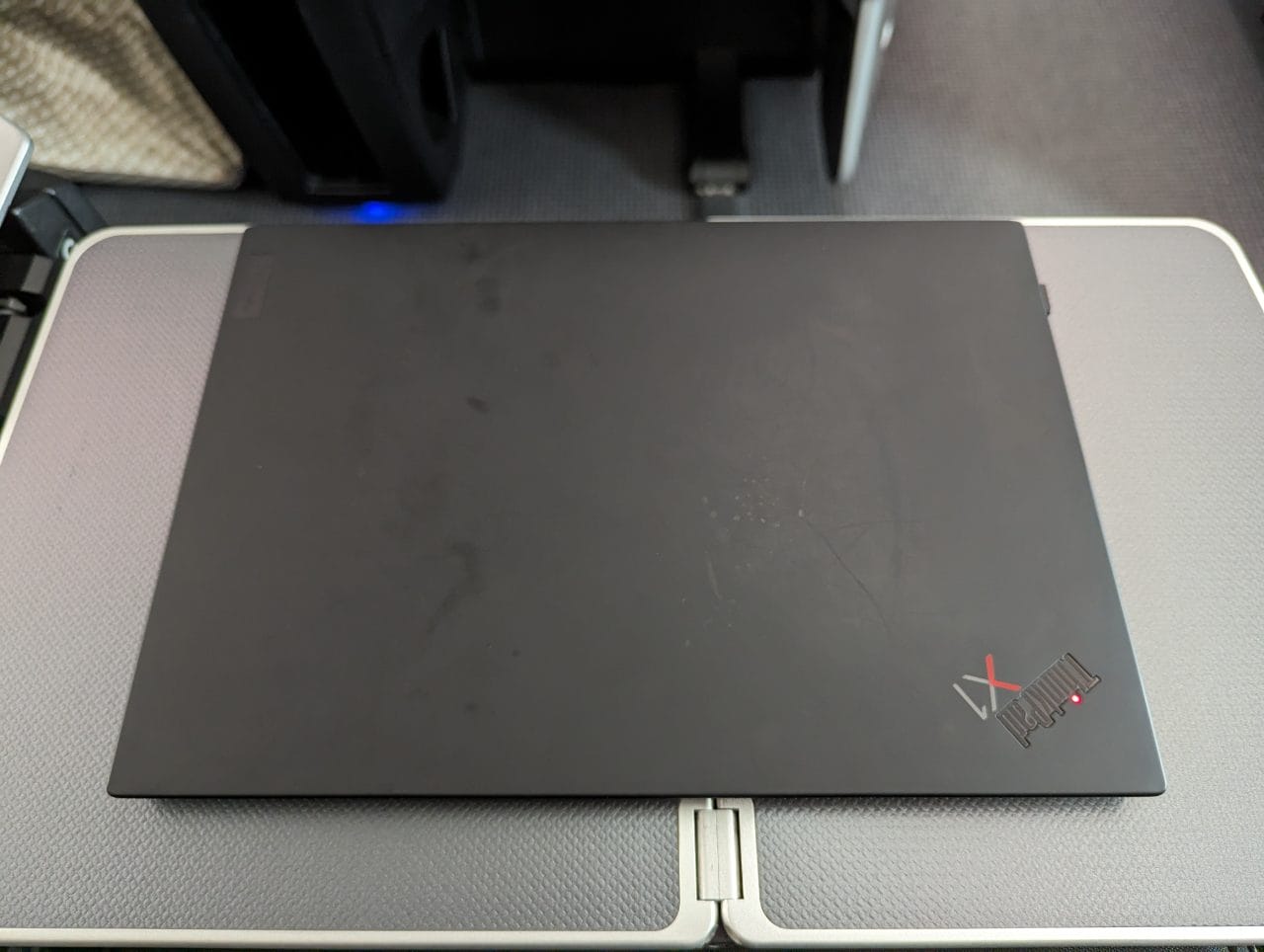
Amenities
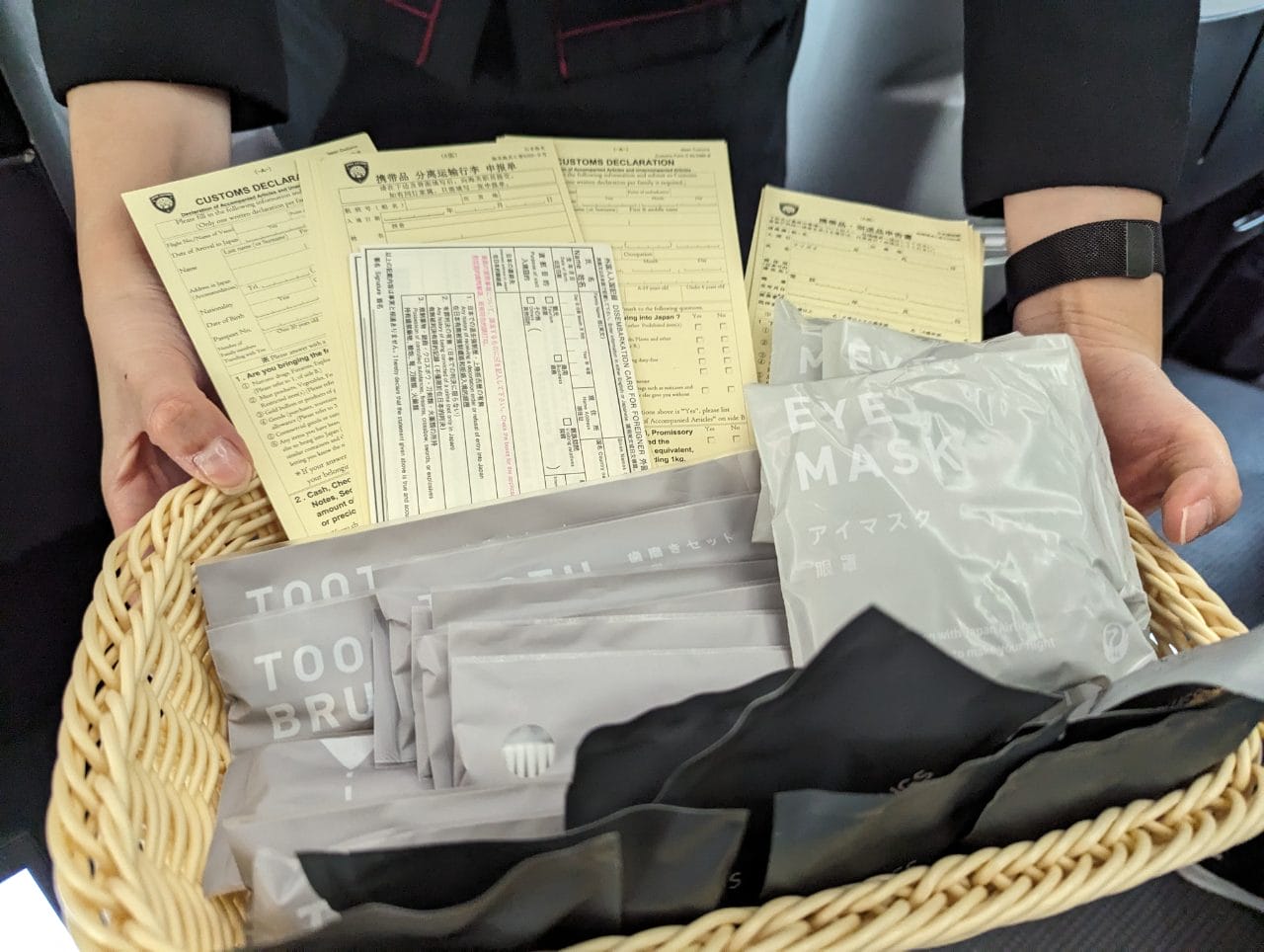
No amenities kit was given out on this flight, but prior to departure the crew came around with a basket with toothbrush kits, eye masks, socks, slippers and earplugs.
I helped myself to a little of each, which together with the fleece blanket made for a comfortable flight.
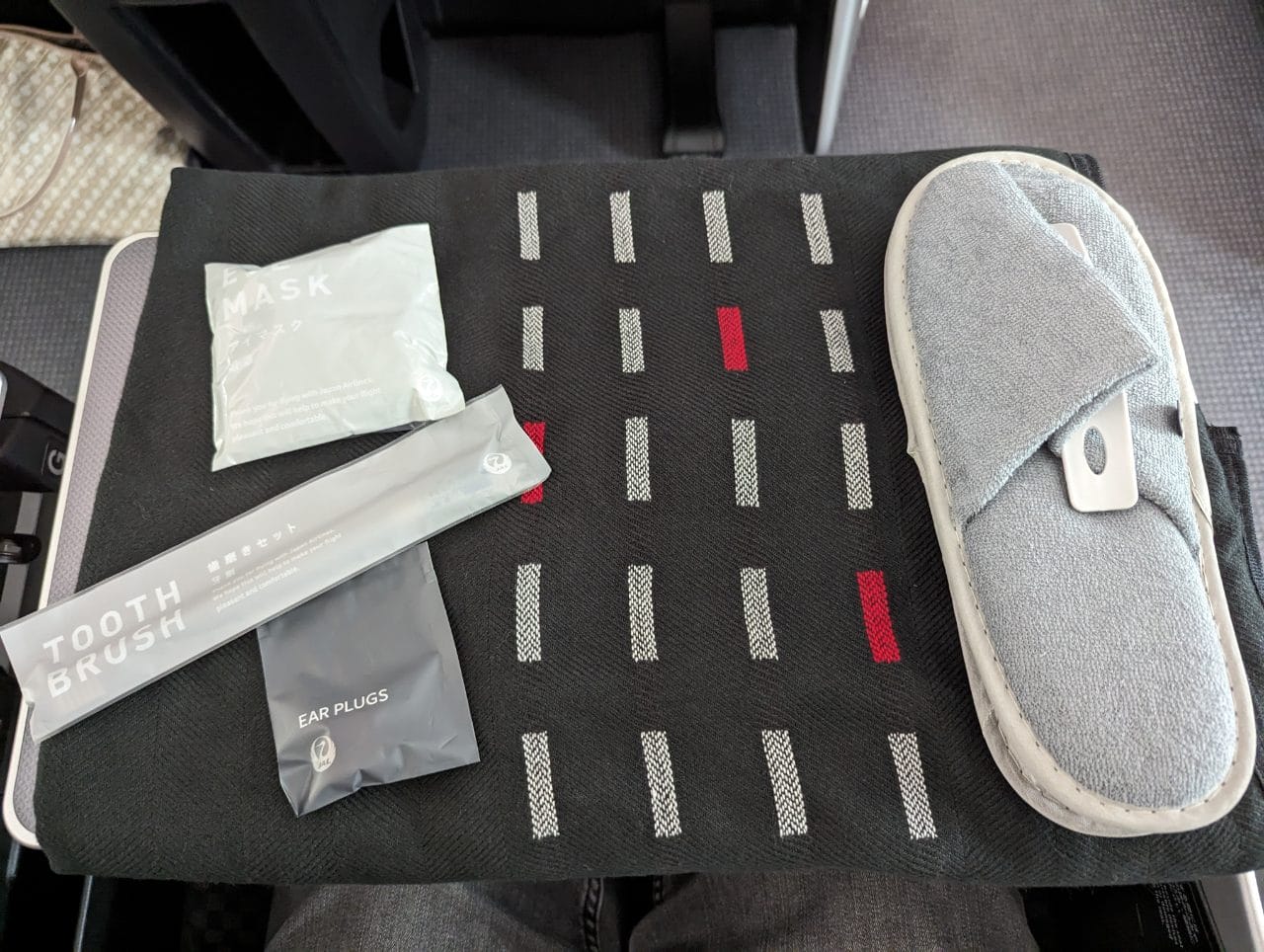
Food & Beverage
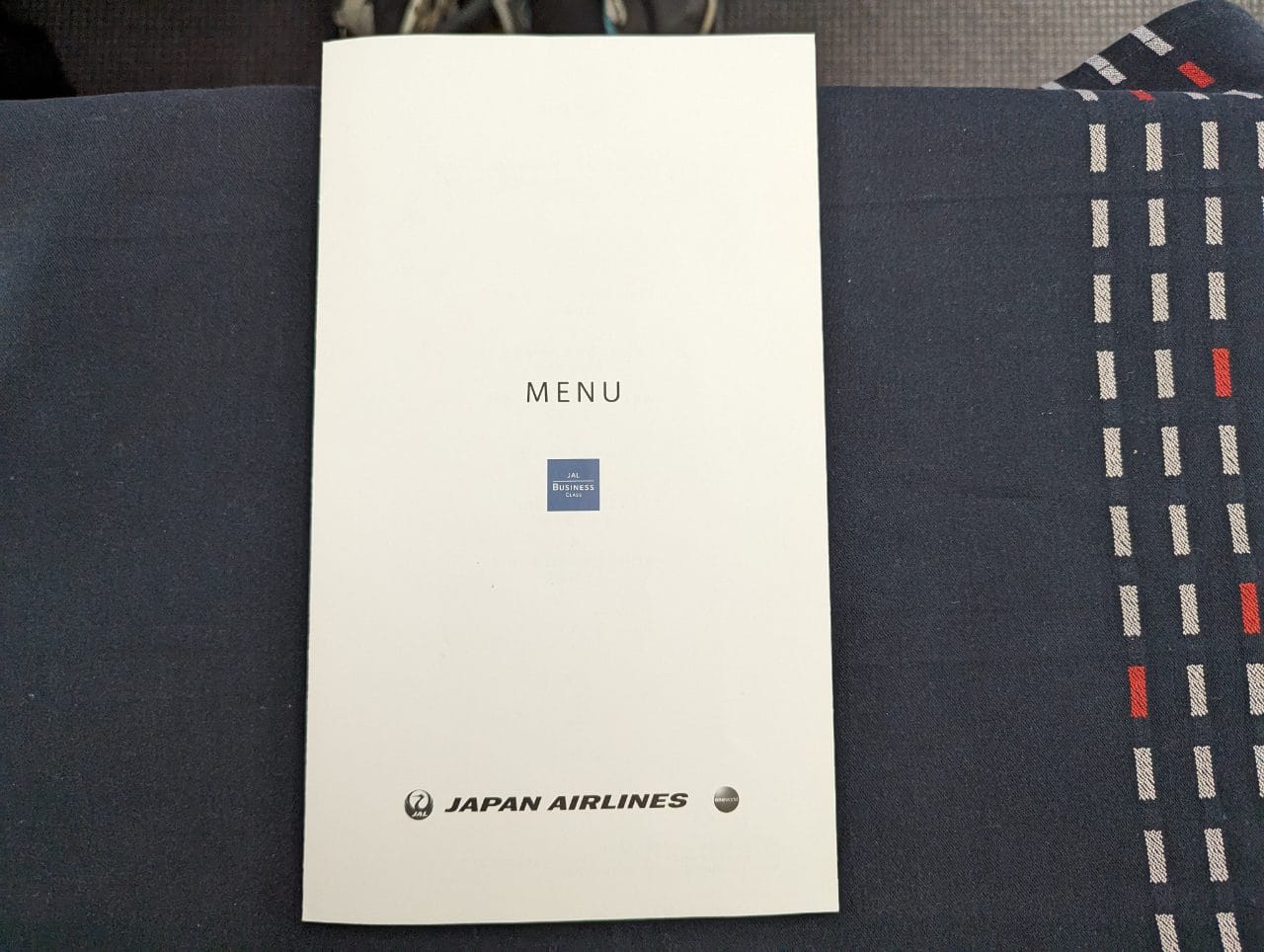
Pre-departure beverages were not served on the ground in Hong Kong, but menus were distributed shortly after take-off and meal orders taken.
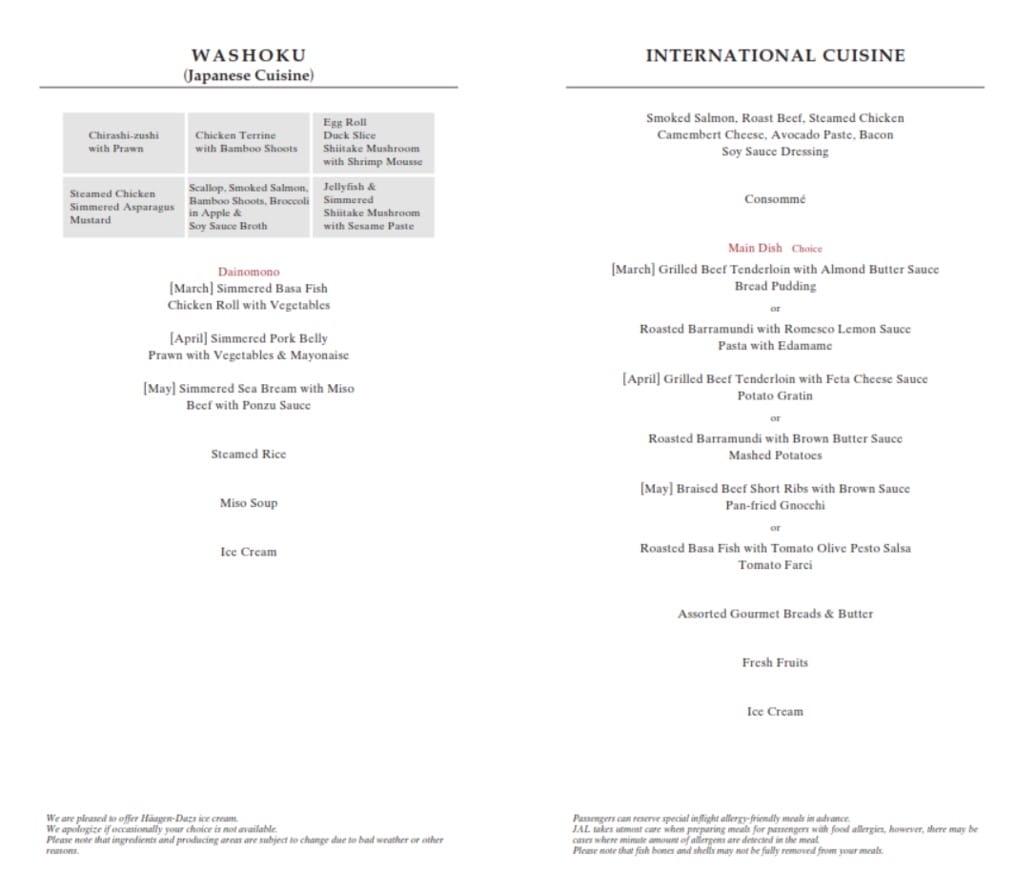
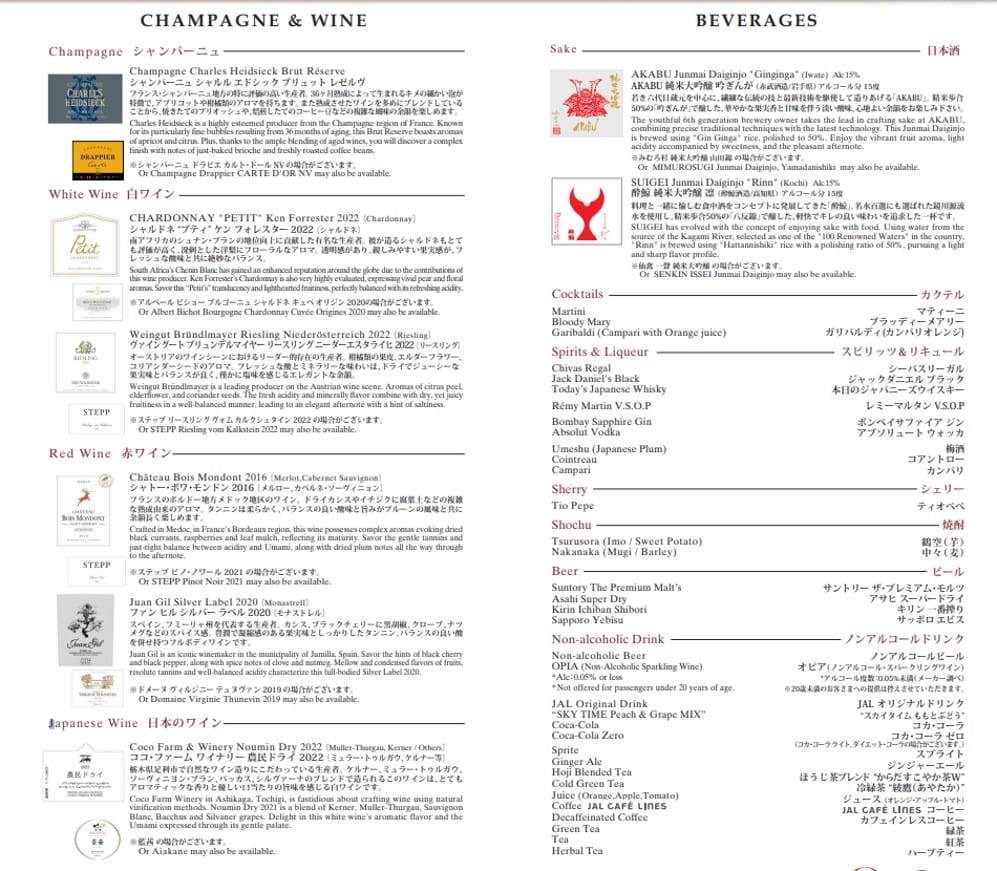
I was pleased to see that they had a choice of two champagnes- rare for Business Class. Both Drappier and Charles Heidsieck were served, and enjoyed together with some rice crackers.
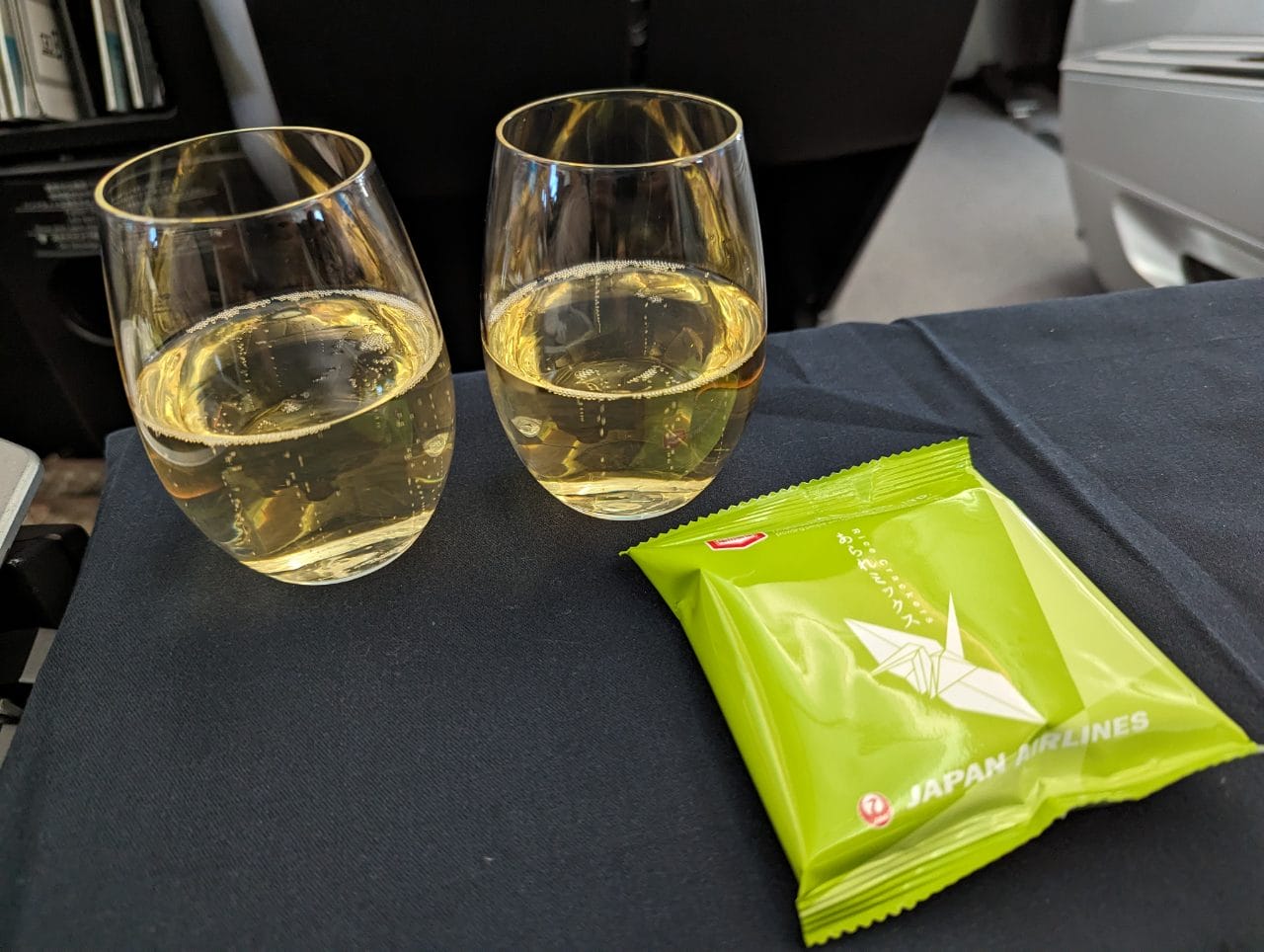
| Wine | Type |
| 🇫🇷 Champagne Drappier Carte D’or NV | Champagne |
| 🇫🇷 Champagne Charles Heidsieck Brut Reserve | Champagne |
| 🇿🇦 Chardonnay Petit Ken Forrester 2021 | White |
| 🇩🇪 STEPP Riesling vom Kalkstein 2022 | White |
| 🇩🇪 STEPP Pinot Noir 2021 | Red |
| 🇪🇸 Juan Gil Silver Label 2020 | Red |
| 🇯🇵 Coco Farm & Winery Noumin Dry 2022 | White |
For the meal, I opted for the Washoku, the Japanese meal option that came beautifully presented (as most things in Japan are) and conveniently illustrated with a diagram in the menu.
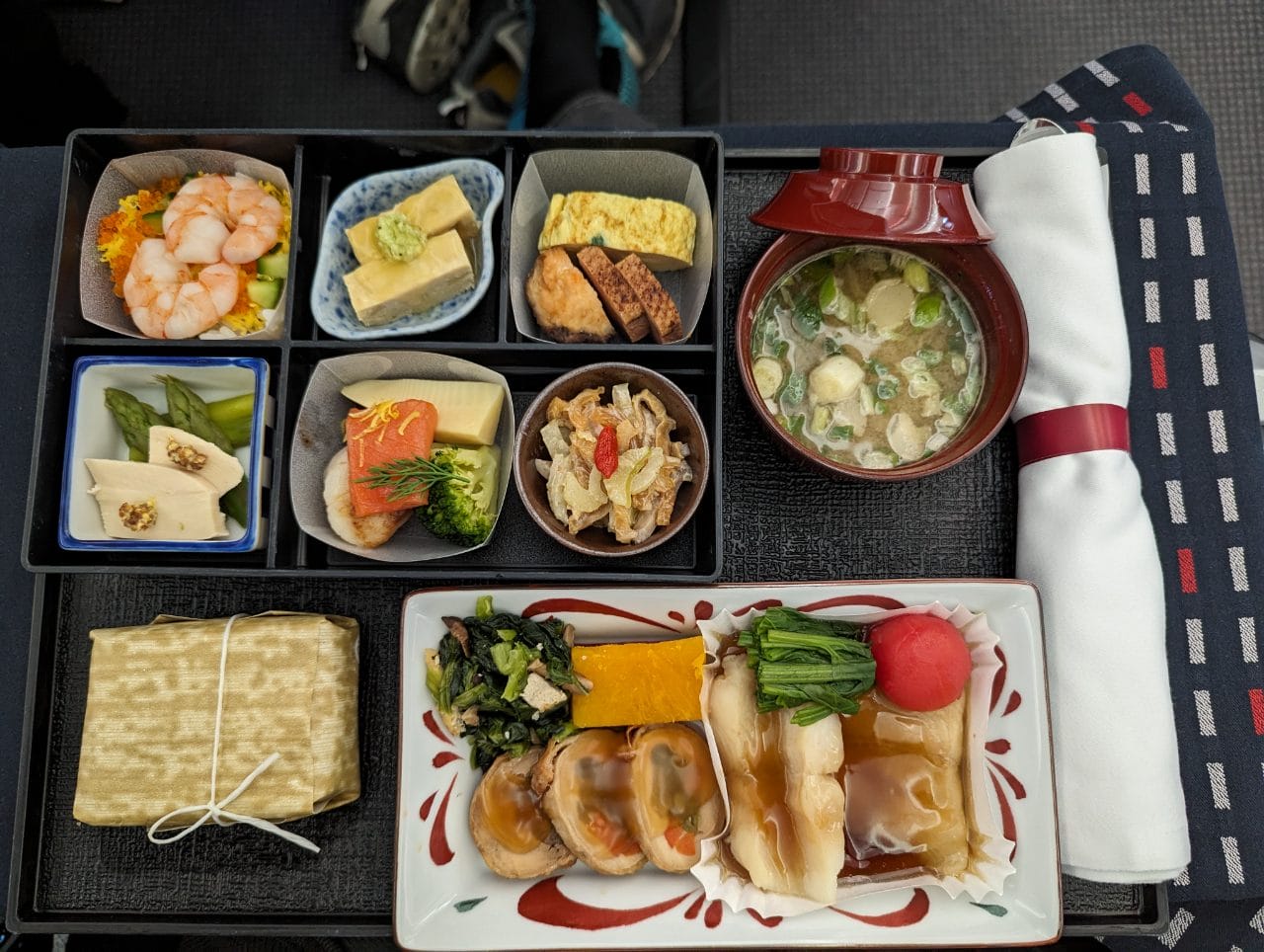
The appetiser platter in the top left had chirashi zushi with prawn, chicken terrine with bamboo shoots, egg roll with duck, mushroom and shrimp mousse, steamed chicken with asparagus, scallop, smoked salmon and bamboo shoots in soy sauce broth, and jellyfish with simmered shiitake mushroom. It sounds like a lot, but each of them was perfectly portioned, and it’s a great way to sample a wide variety of dishes without filling up.
The main course was simmered basa fish with chicken roll and vegetables, accompanied with steamed rice wrapped up in a small paper box. Even though this meal wasn’t catered out of Tokyo (where JAL’s catering is of course the strongest), it was still very competently executed.
There wasn’t a Japanese option for dessert, but Haagen Dazs vanilla is probably a universal language.
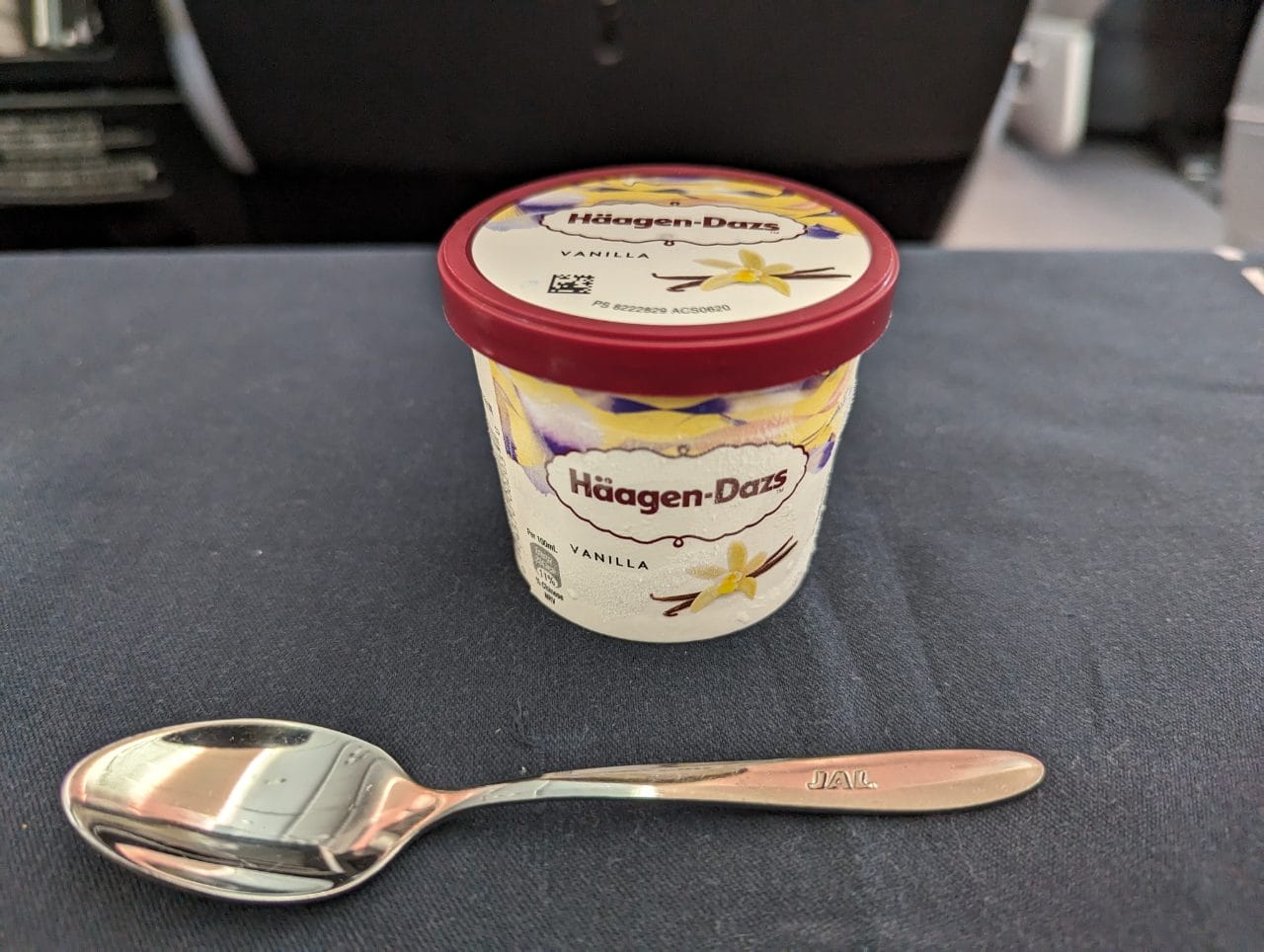
Inflight Entertainment
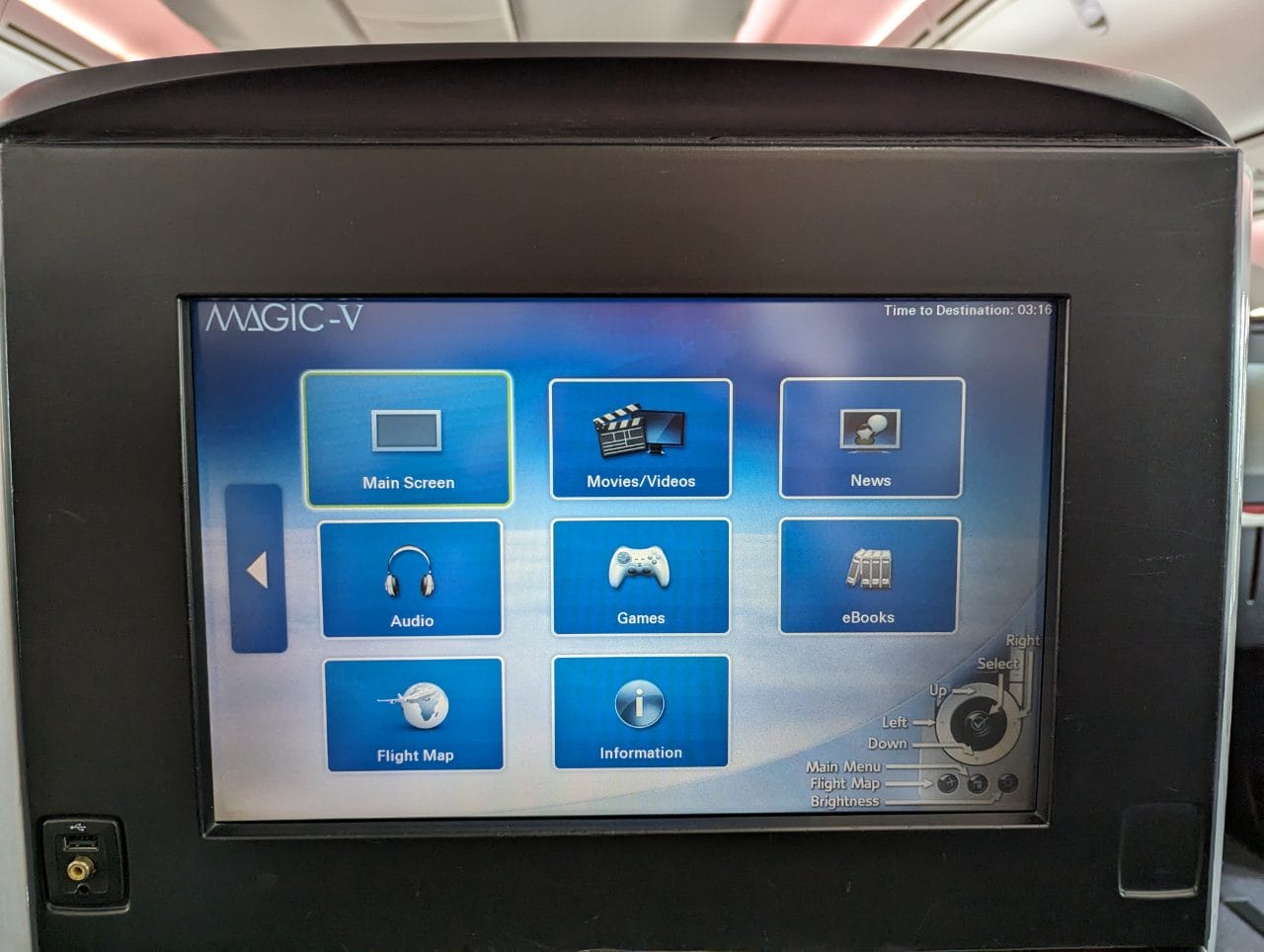
The Boeing 787-8 uses an older version of JAL’s inflight entertainment system called Magic-V.
While older, it at least does one thing better than Magic-VI, which I hate with a vengeance: you can actually browse the selection on the main screen. VI forces you to browse on the handset, which severely limits how many titles you can view at one go and needlessly pads the time required to find something to watch.
However, Magic-V still has JAL’s UX problem whereby the system doesn’t feature nested options. What this means is that a given title can appear multiple times, depending on the language tracks available (versus a nested system which would show the title once, then let the passenger select the language on the next screen).
For example, notice how Killers of the Flower Moon is listed four times. Multiply that by the number of titles in the library, and you’re looking at a lot of scrolling. It’s frustratingly inefficient, and appallingly-designed UX.
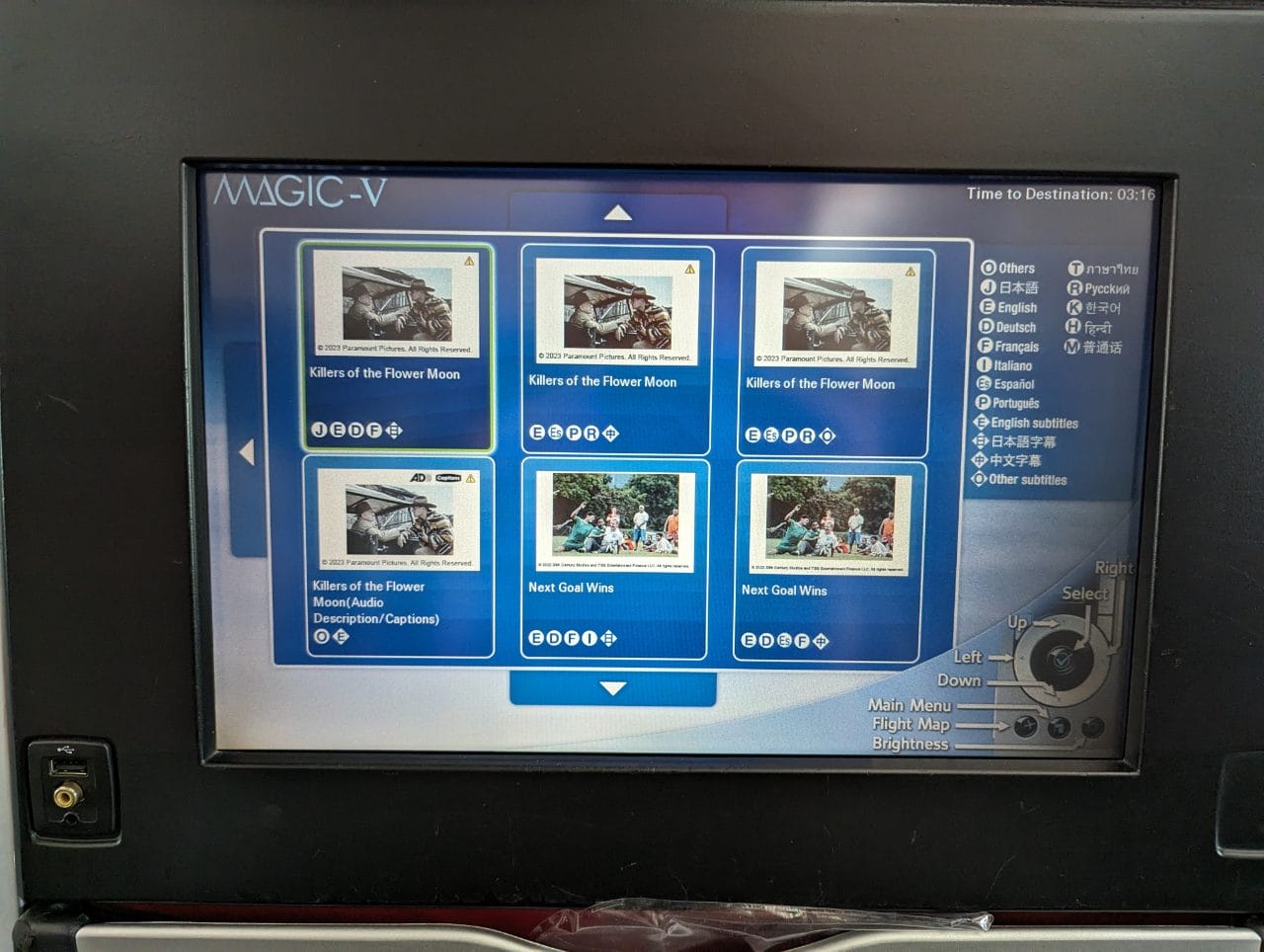
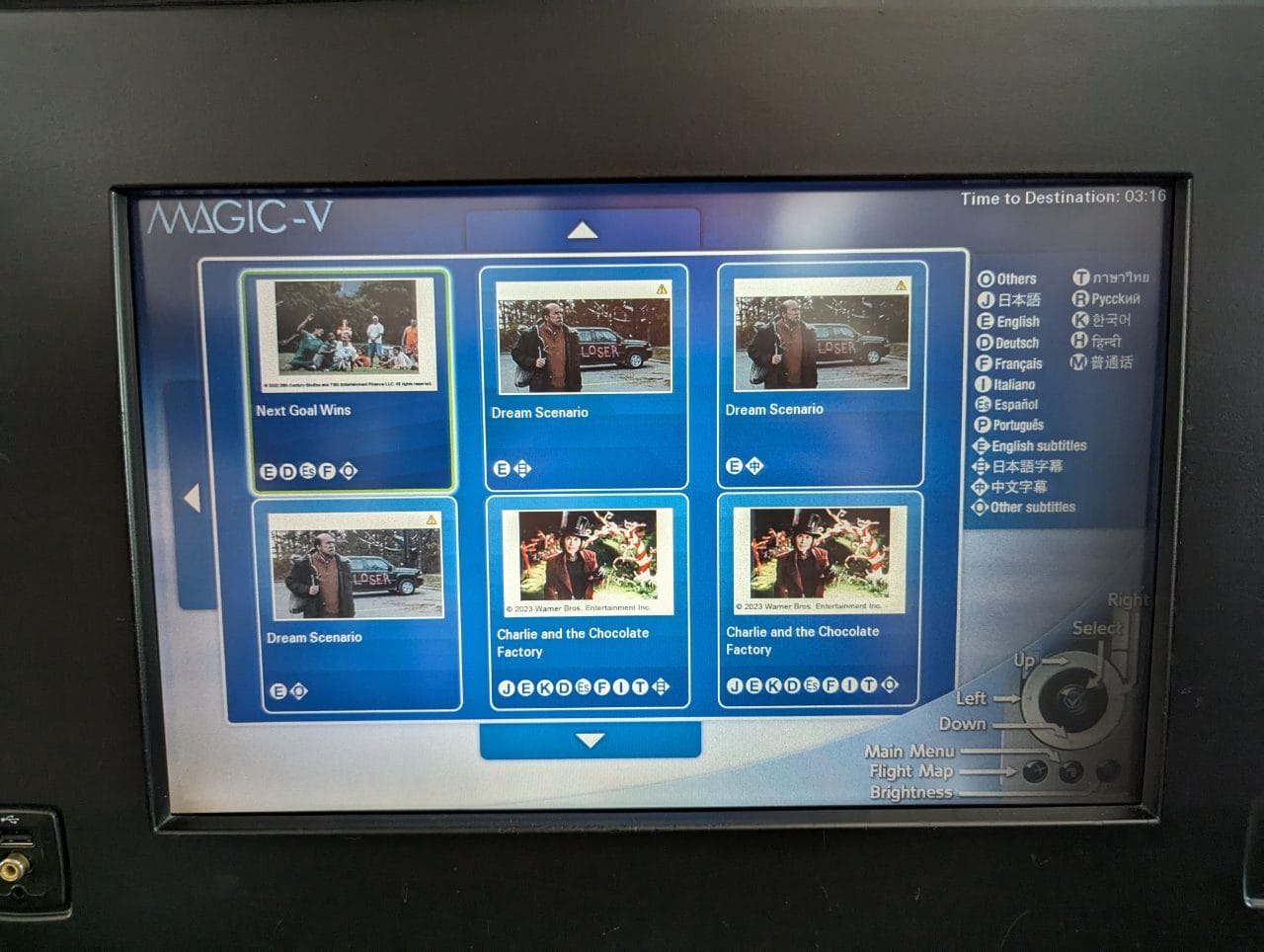
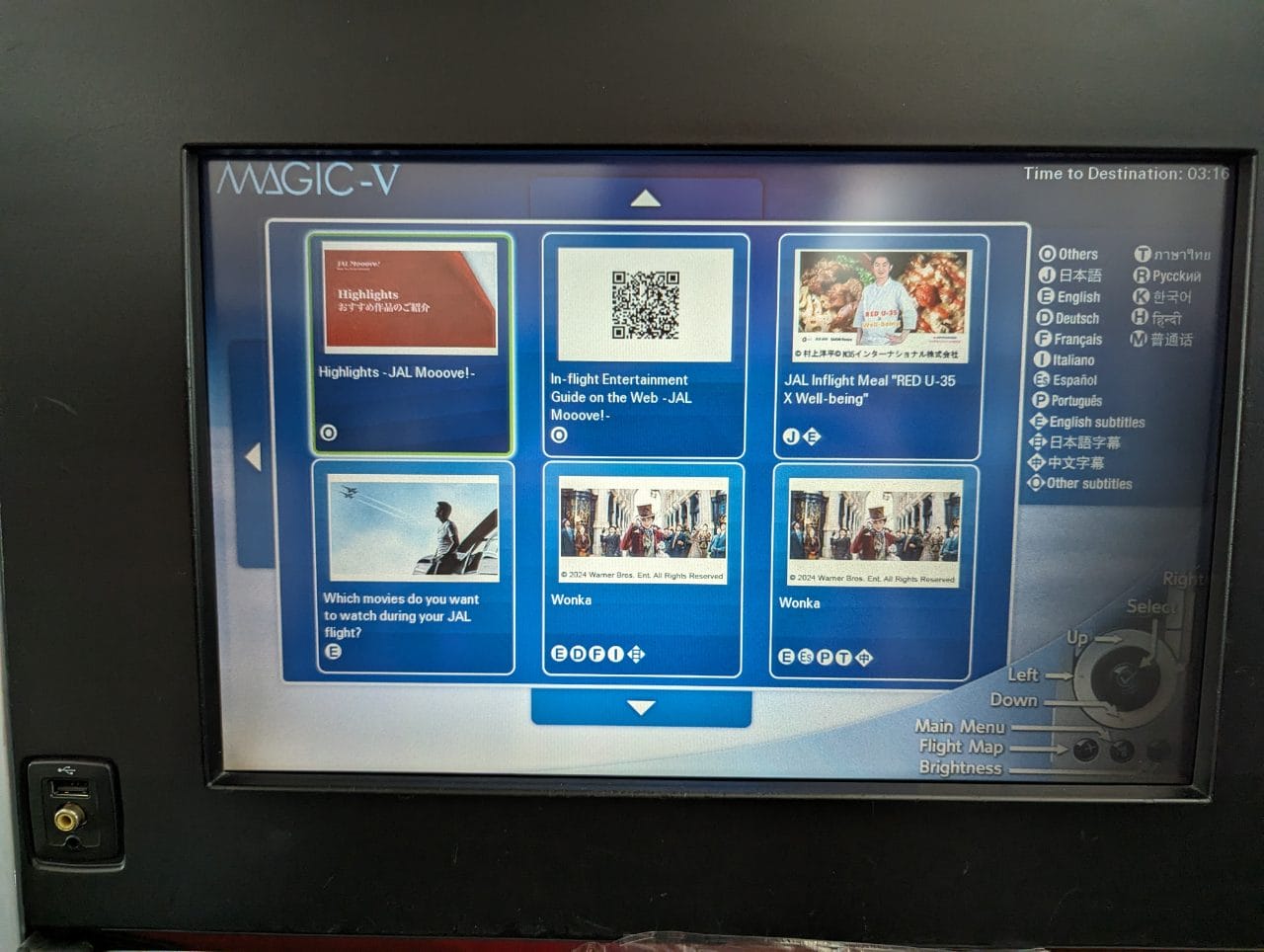
To compound issues, there’s a noticeable lag between operating the remote and the system recognising the input. Sometimes inputs are not recognised at all, other times a single input is captured multiple times, causing you to overshoot your target. It all makes for an extremely frustrating experience.
The movie selection itself was more than adequate for a regional flight- JAL publishes its schedule for a three-month period on its website, and my flight had recent titles like Aquaman And The Lost Kingdom, Napoleon, The Color Purple and Disney’s Wish (probably that the movie had done better).
The same noise-cancelling headphones that you’ll find on JAL’s long-haul flights were provided here, and they get the job done, though they’re a bit on the small side. I would have preferred a model with bigger ear cups that go around the ears (for passive noise cancellation) rather than just sit on them.
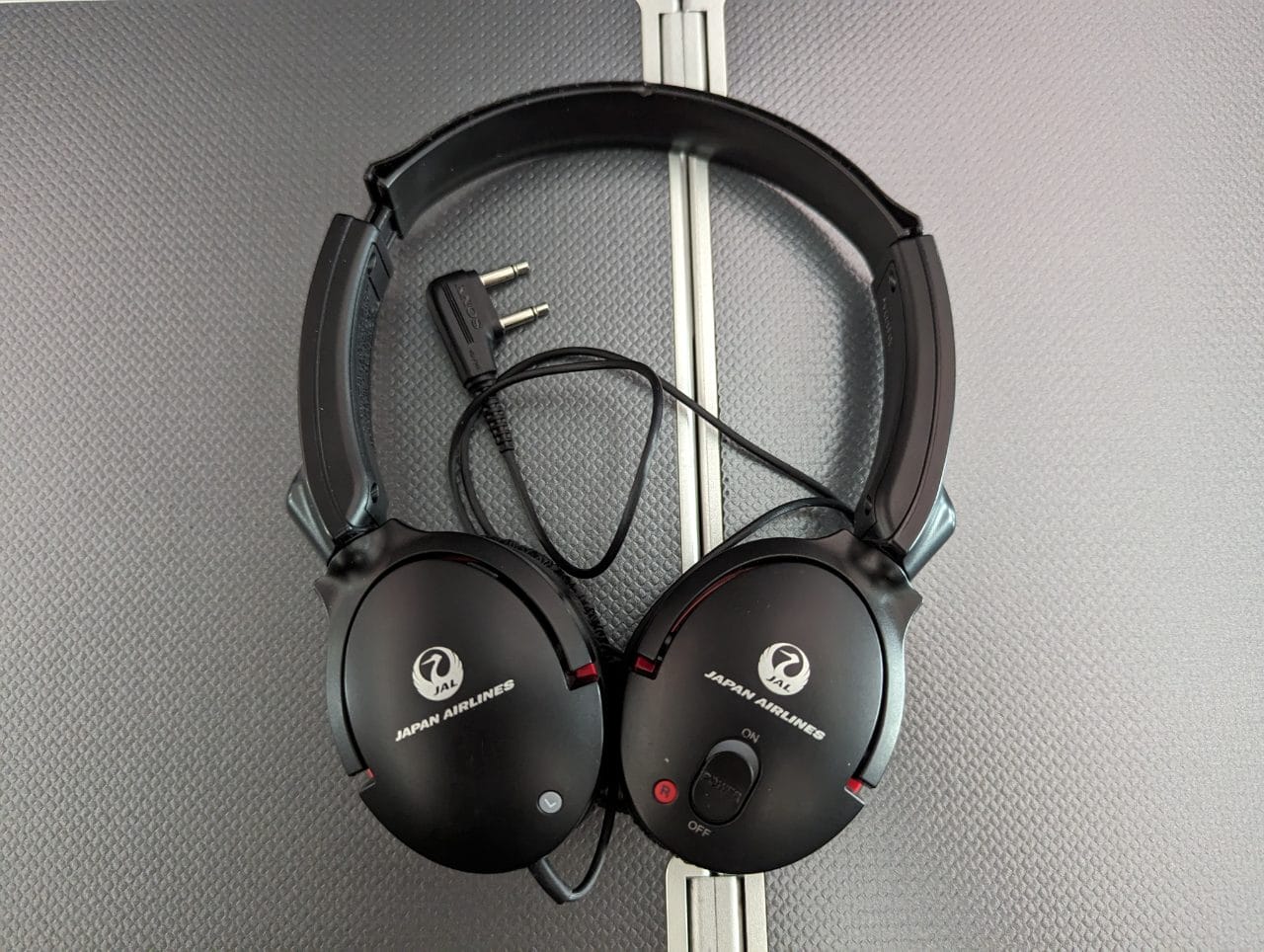
Wi-Fi
Japan Airlines offers inflight connectivity on the vast majority of its international flights, including the B787-8.
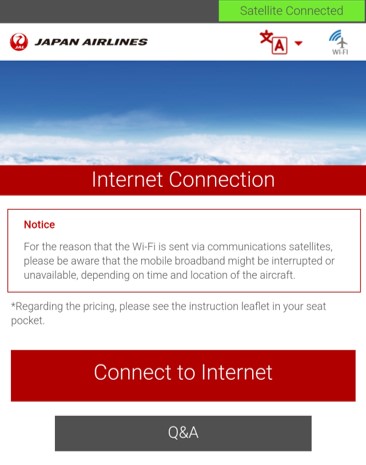
Unfortunately, unlike Singapore Airlines, JAL only offers complimentary Wi-Fi for First Class passengers. Everyone else will need to buy a package, with the pricing given below.
| 📶 JAL Wi-Fi Pricing | |
| Duration | Cost |
| 1-hour | US$10.15 |
| 3-hours | US$14.40 |
| 24-hours | US$18.80 |
| JALCARD holders enjoy discounted prices of US$9.15/ US$12.95/ US$16.80 for the 1/3/24 hour plans respectively | |
Japan Airlines also does not offer mobile network connectivity in its cabin. This matters in case you’re trying to receive an SMS OTP for online banking or shopping.
Sleep Experience
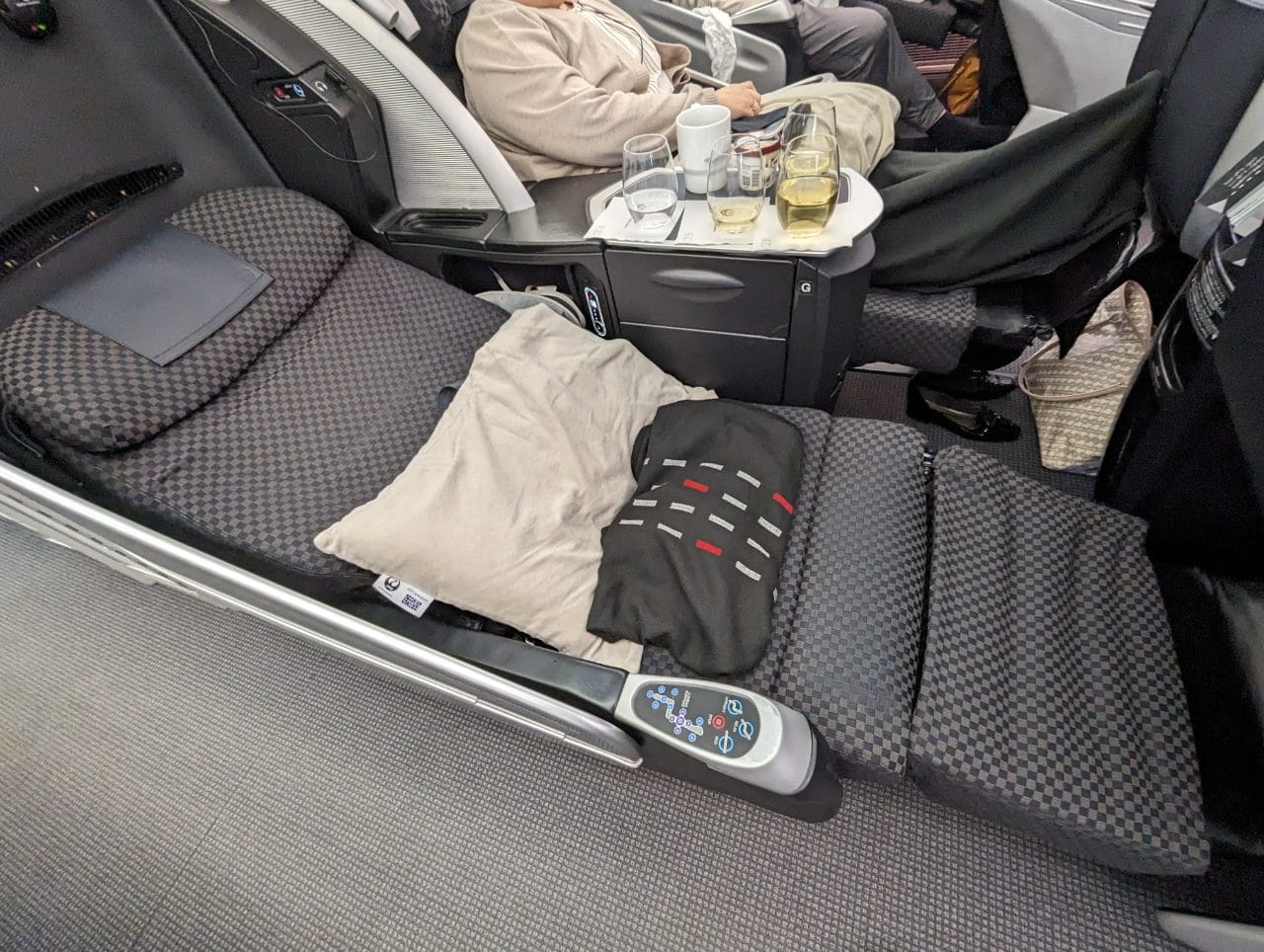
As mentioned earlier, the Shell Flat Neo is an angled-flat seat, so your sleep experience will be far from ideal. With the seat in “full flat” mode, you’ll eventually start sliding towards the bottom- though at least the seat material is more “grippy” than the smooth leather that Singapore Airlines used on their last-gen Regional Business Class seats, which delays the inevitable somewhat.
This means the seat is best put in the lounging position for a short nap, and thankfully I was on a daytime flight. I do pity those who end up with this aircraft on a red-eye!
Toilet
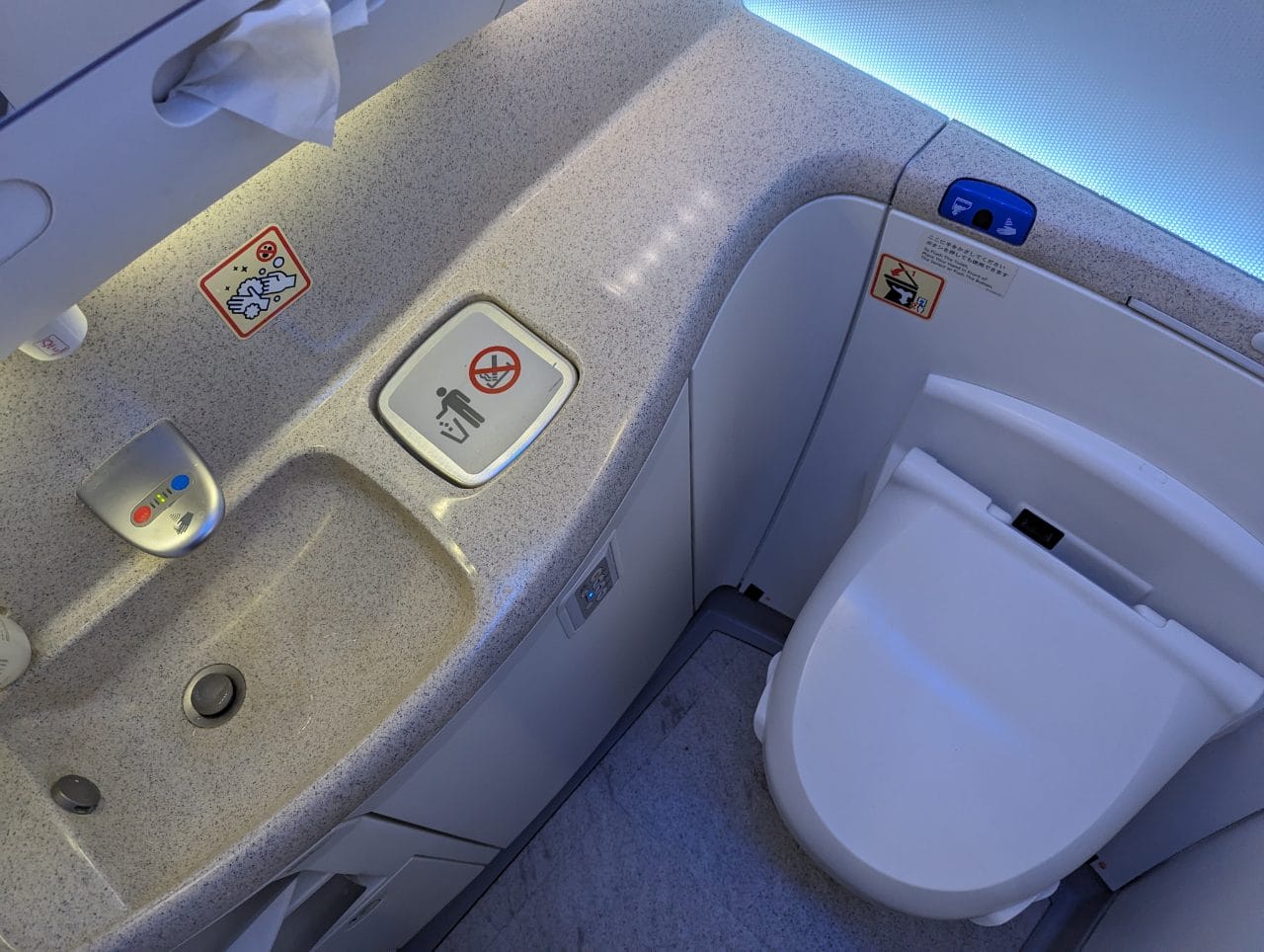
The 30 Business Class passengers on JAL’s B787-8 have access to three lavatories- one at the front of the cabin, and two at the rear.
These were kept clean throughout the duration of the flight, and all are equipped with bidets. Even though this was Business Class, there weren’t any fancy toiletries in the lavatory to speak of.
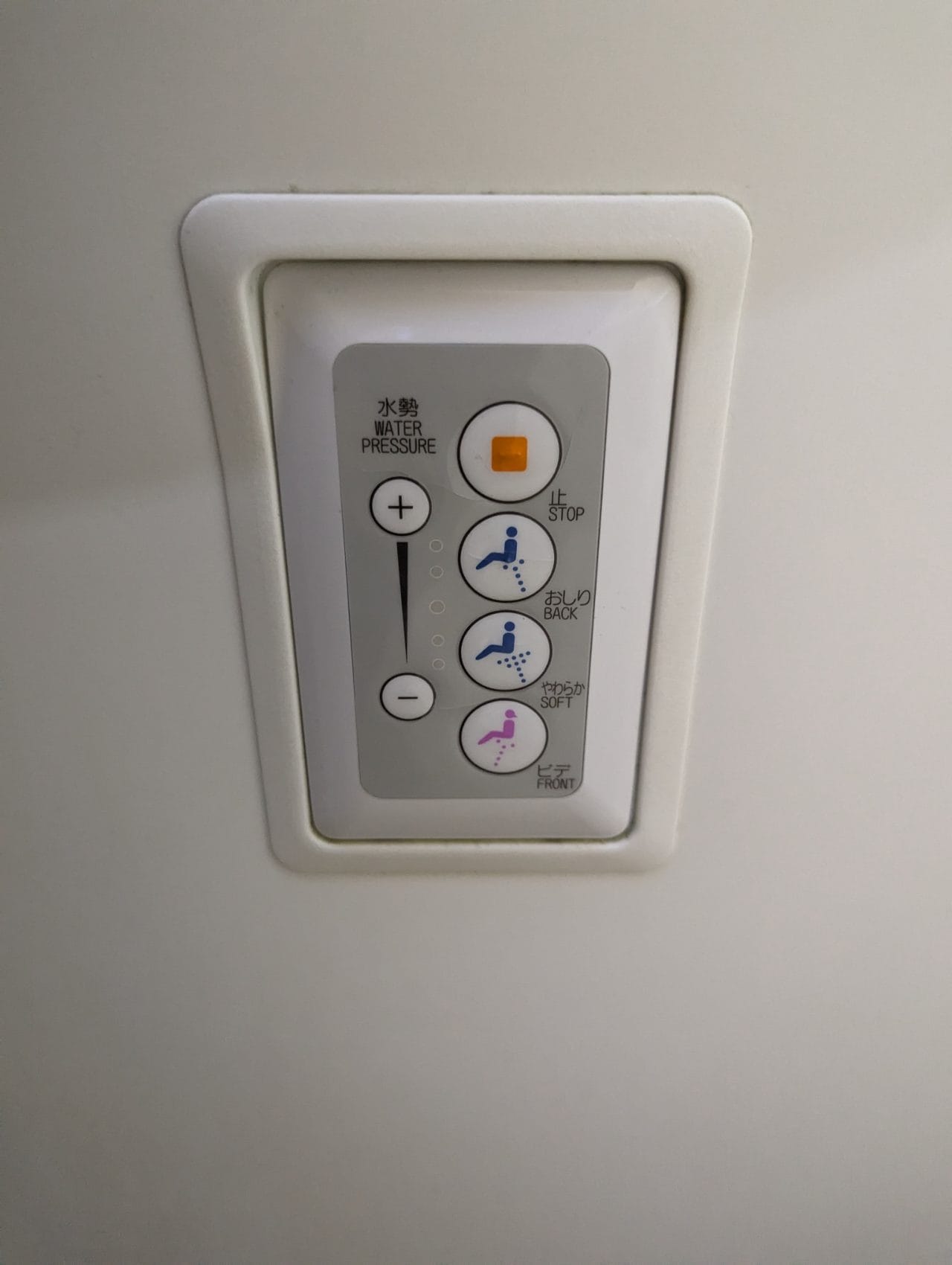
Conclusion
Japan Airlines’ otherwise solid service and catering are let down by an outdated hard product on their Boeing 787-8s, with this regional Business Class seat at least a couple of generations out of date.
It’s passable for a daytime flight where at most you’ll need a brief power nap, but anyone who pays good money (or miles) for Business Class and ends up with this on a redeye flight is bound to be disappointed.
Perhaps the bigger concern is that regional Business Class is not currently an investment area for JAL. Most of their energies over the next couple of years will be the rollout of their new long-haul First and Business Class seats, and as nice as those are, they’re going to be the exception rather than the rule for the foreseeable future.
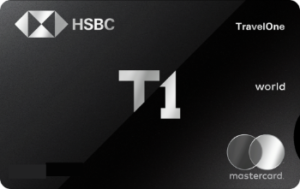




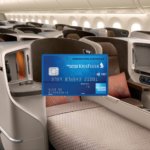

Thanks for the review.
To answer your question: apparently they install the plugs upside-down as, especially for the 3-pronged plug, you lose less cord when using the device while seated. This as the cord doesn’t have to make a hairpin bend, as usually the cord is attached to the bottom of the plug.
It’s what I’ve heard but there could be another reason.
The plug is perfectly rotated for the grounded NEMA power plug.
i’m surprised to find IFEs not working on Japanese aircraft, given the (ok, my) impression for their dedication towards excellence. And in J class no less. How many IFEs/J seats were not functioning properly, you know? How old are these 788s?
Are you referring to the Japan of yesteryear or today?
The roman empire took its time towards its end.
I would even say the new China Eastern J seats is better than some of the JAL/ANA config.
Unless you scored the new A350-1000. Otherwise their Sky Suite 3 is quite old too.
I guess while holding the plug in hand and lowering it to the seat socket, the flip in orientation is natural. Also the orientation of the cord toward the direction it extends makes sense for that end to point up.